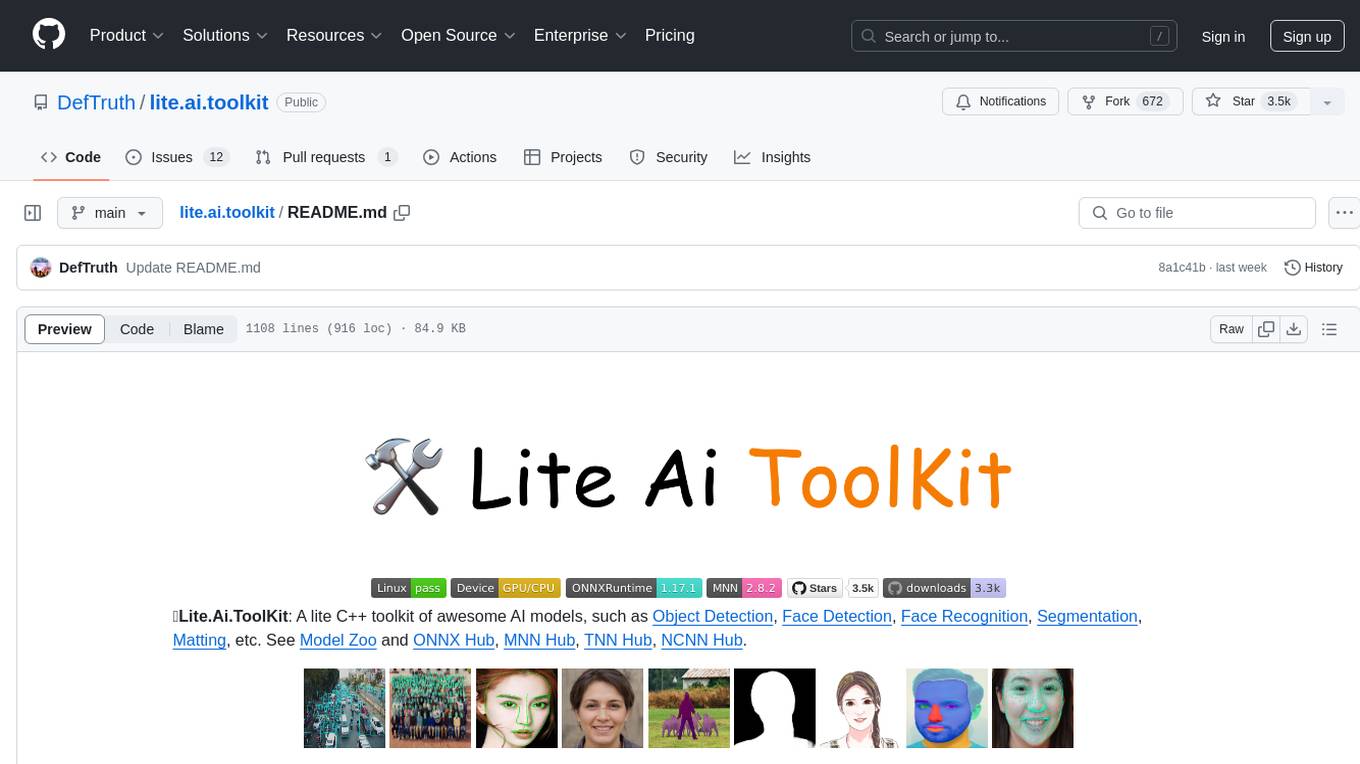
wenda
闻达:一个LLM调用平台。目标为针对特定环境的高效内容生成,同时考虑个人和中小企业的计算资源局限性,以及知识安全和私密性问题
Stars: 6269
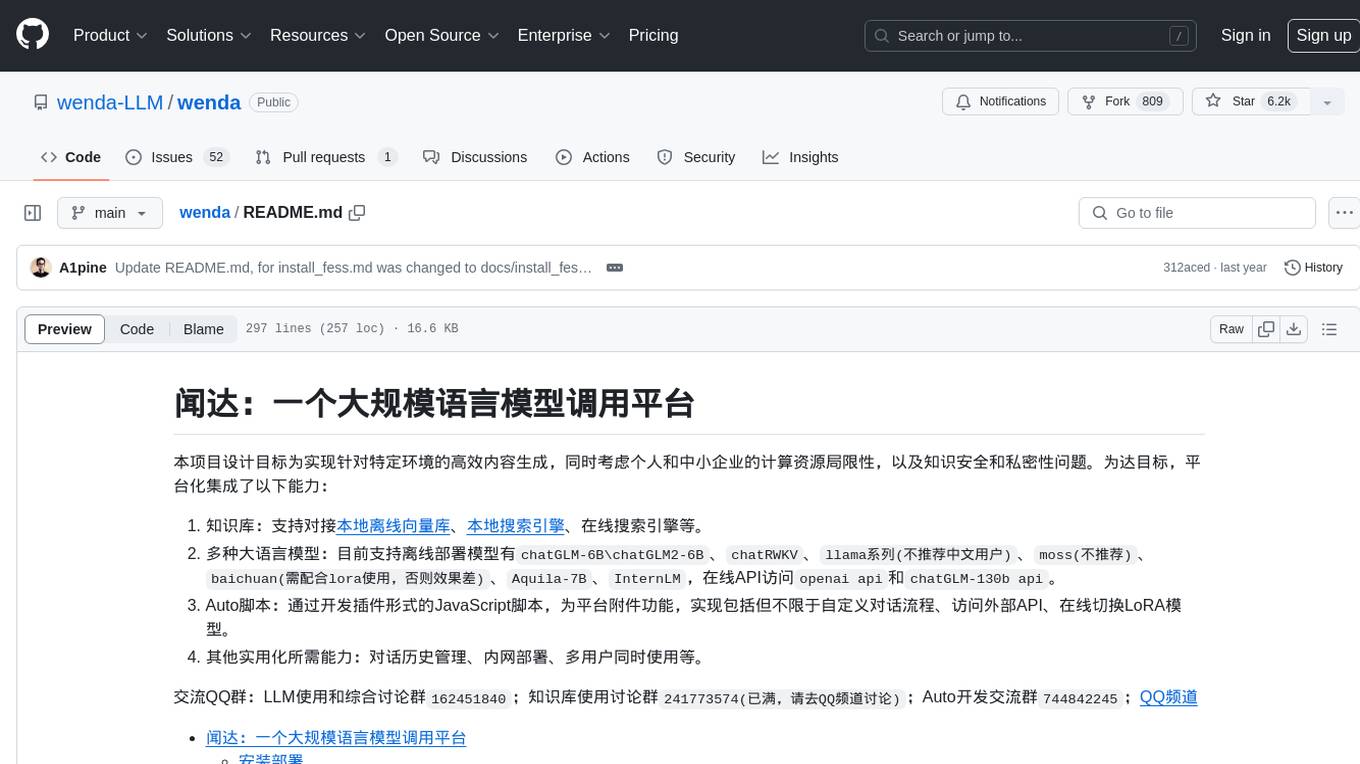
Wenda is a platform for large-scale language model invocation designed to efficiently generate content for specific environments, considering the limitations of personal and small business computing resources, as well as knowledge security and privacy issues. The platform integrates capabilities such as knowledge base integration, multiple large language models for offline deployment, auto scripts for additional functionality, and other practical capabilities like conversation history management and multi-user simultaneous usage.
README:
本项目设计目标为实现针对特定环境的高效内容生成,同时考虑个人和中小企业的计算资源局限性,以及知识安全和私密性问题。为达目标,平台化集成了以下能力:
- 知识库:支持对接本地离线向量库、本地搜索引擎、在线搜索引擎等。
- 多种大语言模型:目前支持离线部署模型有
chatGLM-6B\chatGLM2-6B、chatRWKV、llama系列(不推荐中文用户)、moss(不推荐)、baichuan(需配合lora使用,否则效果差)、Aquila-7B、InternLM,在线API访问openai api和chatGLM-130b api。 - Auto脚本:通过开发插件形式的JavaScript脚本,为平台附件功能,实现包括但不限于自定义对话流程、访问外部API、在线切换LoRA模型。
- 其他实用化所需能力:对话历史管理、内网部署、多用户同时使用等。
交流QQ群:LLM使用和综合讨论群162451840;知识库使用讨论群241773574(已满,请去QQ频道讨论);Auto开发交流群744842245;QQ频道
| 功能 | 多用户并行 | 流式输出 | CPU | GPU | 量化 | 外挂LoRa |
|---|---|---|---|---|---|---|
| chatGLM-6B/chatGLM2-6B | √ | √ | 需安装编译器 | √ | 预先量化和在线量化 | √ |
| RWKV torch | √ | √ | √ | √ | 预先量化和在线量化 | |
| RWKV.cpp | √ | √ | 可用指令集加速 | 预先量化 | ||
| Baichuan-7B | √ | √ | √ | √ | √ | |
| Baichuan-7B (GPTQ) | √ | √ | √ | 预先量化 | ||
| Aquila-7B | 官方未实现 | √ | √ | |||
| replit | √ | √ | ||||
| chatglm130b api | √ | |||||
| openai api | √ | √ | ||||
| llama.cpp | √ | √ | 可用指令集加速 | 预先量化 | ||
| llama torch | √ | √ | √ | √ | 预先量化和在线量化 | |
| InternLM | √ | √ | √ | √ | 在线量化 |
https://pan.baidu.com/s/1idvot-XhEvLLKCbjDQuhyg?pwd=wdai
链接:https://pan.quark.cn/s/c4cb08de666e 提取码:4b4R
默认参数在6G显存设备上运行良好。最新版懒人版已集成一键更新功能,建议使用前更新。
使用步骤(以glm6b模型为例):
- 下载懒人版主体和模型,模型可以用内置脚本从HF下载,也可以从网盘下载。
- 如果没有安装
CUDA11.8,从网盘下载并安装。 - 双击运行
运行GLM6B.bat。 - 如果需要生成离线知识库,参考 知识库。
PS:一定要看example.config.yml,里面对各功能有更详细的说明!!!
通用依赖:pip install -r requirements/requirements.txt
根据使用的 知识库进行相应配置
根据需要,下载对应模型。
建议使用chatRWKV的RWKV-4-Raven-7B-v11,或chatGLM-6B。
把example.config.yml重命名为config.yml,根据里面的参数说明,填写你的模型下载位置等信息
auto功能通过JavaScript脚本实现,使用油猴脚本或直接放到autos目录的方式注入至程序,为闻达附加各种自动化功能。
| 函数 (皆为异步调用) | 功能 | 说明 |
|---|---|---|
| send(s,keyword = "",show=true) | 发送信息至LLM,返回字符串为模型返回值 | s:输入模型文本;keyword:聊天界面显示文本;show:是否在聊天界面显示 |
| add_conversation(role, content) | 添加会话信息 | role:'AI'、'user';content:字符串 |
| save_history() | 保存会话历史 | 对话完成后会自动保存,但手动添加的对话须手动保存 |
| find(s, step = 1) | 从知识库查找 | 返回json数组 |
| find_dynamic(s,step=1,paraJson) | 从动态知识库查找;参考闻达笔记Auto | paraJson:{libraryStategy:"sogowx:3",maxItmes:2} |
| zsk(b=true) | 开关知识库 | |
| lsdh(b=true) | 开关历史对话 | 打开知识库时应关闭历史 |
| speak(s) | 使用TTS引擎朗读文本。 | 调用系统引擎 |
| copy(s) | 使用浏览器clipboard-write复制文本 |
需要相关权限 |
在左侧功能栏添加内容:
func.push({
name: "名称",
question: async () => {
let answer=await send(app.question)
alert(answer)
},
})
在下方选项卡添加内容:
app.plugins.push({ icon: 'note-edit-outline', url: "/static/wdnote/index.html" })
在指定RTST知识库查找:
find_in_memory = async (s, step, memory_name) => {
response = await fetch("/api/find_rtst_in_memory", {
method: 'post',
body: JSON.stringify({
prompt: s,
step: step,
memory_name: memory_name
}),
headers: {
'Content-Type': 'application/json'
}
})
let json = await response.json()
console.table(json)
app.zhishiku = json
return json
}
上传至指定RTST知识库:
upload_rtst_zhishiku = async (title, txt,memory_name) => {
response = await fetch("/api/upload_rtst_zhishiku", {
method: 'post',
body: JSON.stringify({
title: title,
txt: txt,
memory_name: memory_name
}),
headers: { 'Content-Type': 'application/json' }
})
alert(await response.text())
}
保存指定RTST知识库:
save_rtst = async (memory_name) => {
response = await fetch("/api/save_rtst_zhishiku", {
method: 'post',
body: JSON.stringify({
memory_name: memory_name
}),
headers: { 'Content-Type': 'application/json' }
})
alert(await response.text())
}
访问SD_agent:
response = await fetch("/api/sd_agent", {
method: 'post',
body: JSON.stringify({
prompt: `((masterpiece, best quality)), photorealistic,` + Q,
steps: 20,
// sampler_name: "DPM++ SDE Karras",
negative_prompt: `paintings, sketches, (worst quality:2), (low quality:2), (normal quality:2), lowres, normal quality, ((monochrome)), ((grayscale)), skin spots, acnes, skin blemishes, age spot, glans`
}),
headers: {
'Content-Type': 'application/json'
}
})
try {
let json = await response.json()
add_conversation("AI", '")
} catch (error) {
alert("连接SD API失败,请确认已开启agents库,并将SD API地址设置为127.0.0.1:786")
}
| 文件名 | 功能 |
|---|---|
| 0-write_article.js | 写论文:根据题目或提纲写论文 |
| 0-zsk.js | 知识库增强和管理 |
| face-recognition.js | 纯浏览器端人脸检测:通过识别嘴巴开合,控制语音输入。因浏览器限制,仅本地或TLS下可用 |
| QQ.js | QQ机器人:配置过程见文件开头注释 |
| block_programming.js | 猫猫也会的图块化编程:通过拖动图块实现简单Auto功能 |
| 1-draw_use_SD_api.js | 通过agents模块(见example.config.yml<Library>)调用Stable Diffusion接口绘图 |
以上功能主要用于展示auto用法,进一步能力有待广大用户进一步发掘。




知识库原理是在搜索后,生成一些提示信息插入到对话里面,知识库的数据就被模型知道了。rtst模式计算语义并在本地数据库中匹配;fess模式(相当于本地搜索引擎)、bing模式均调用搜索引擎搜索获取答案。
为防止爆显存和受限于模型理解能力,插入的数据不能太长,所以有字数和条数限制,这一问题可通过知识库增强Auto解决。
有以下几种方案:
- rtst模式,sentence_transformers+faiss进行索引,支持预先构建索引和运行中构建。
- bing模式,cn.bing搜索,仅国内可用
- bingsite模式,cn.bing站内搜索,仅国内可用
- fess模式,本地部署的fess搜索,并进行关键词提取
sentence_transformers+faiss进行索引、匹配,并连同上下文返回。目前支持txt和pdf格式。
支持预先构建索引和运行中构建,其中,预先构建索引强制使用cuda,运行中构建根据config.yml(复制example.config.yml)中rtst段的device(embedding运行设备)决定,对于显存小于12G的用户建议使用CPU。
Windows预先构建索引运行:plugins/buils_rtst_default_index.bat。
Linux直接使用wenda环境执行 python plugins/gen_data_st.py
需下载模型置于model文件夹,并将txt格式语料置于txt文件夹。
闻达用户“帛凡”,训练并提供的权重合并模型和lora权重文件,详细信息见https://huggingface.co/fb700/chatglm-fitness-RLHF ,使用该模型或者lora权重文件,对比hatglm-6b、chatglm2-6b、百川等模型,在闻达知识库平台中,总结能力可获得显著提升。
- GanymedeNil/text2vec-large-chinese 不再推荐,不支持英文且显存占用高
- moka-ai/m3e-base 推荐
在本机使用默认端口安装fess后可直接运行。否则需修改config.yml(复制example.config.yml)中fess_host的127.0.0.1:8080为相应值。FESS安装教程
安装 utool 工具,uTools 是一个极简、插件化的桌面软件,可以安装各种使用 nodejs 开发的插件。您可以使用插件对闻达的知识库进行数据清洗。请自行安装以下推荐插件:
- 插件“解散文件夹”,用于将子目录的文件移动到根目录,并删除所有子目录。
- 插件“重复文件查找”,用于删除目录中的重复文件,原理是对比文件 md5。
- 插件“文件批量重命名”,用于使用正则匹配和修改文件名,并将分类后的文件名进行知识库的分区操作。
运行:run_GLM6B.bat。
模型位置等参数:修改config.yml(复制example.config.yml)。
默认参数在GTX1660Ti(6G显存)上运行良好。
支持torch和cpp两种后端实现,运行:run_rwkv.bat。
模型位置等参数:见config.yml(复制example.config.yml)。
可使用内置脚本对模型量化,运行:cov_torch_rwkv.bat。此操作可以加快启动速度。
在安装vc后支持一键启动CUDA加速,运行:run_rwkv_with_vc.bat。强烈建议安装!!!
可使用内置脚本对torch版模型转换和量化。 运行:cov_ggml_rwkv.bat。
设置strategy诸如"Q8_0->8"即支持量化在cpu运行,速度较慢,没有显卡或者没有nvidia显卡的用户使用。
注意:默认windows版本文件为AVX2,默认Liunx版本文件是在debian sid编译的,其他linux发行版本未知。
可以查看:saharNooby/rwkv.cpp,下载其他版本,或者自行编译。
- 运行
pip install FlagAI。注意FlagAI依赖很多旧版本的包,需要自己编译,所以如果想基于python3.11运行或者想在一个环境同时跑其他模型,建议去下懒人包 - 运行:
run_Aquila.bat。
模型位置等参数:见config.yml(复制example.config.yml)。注意模型要在这里下:https://model.baai.ac.cn/model-detail/100101
项目调用闻达的 api 接口实现类似于 new bing 的功能。 技术栈:vue3 + element-plus + ts

For Tasks:
Click tags to check more tools for each tasksFor Jobs:
Alternative AI tools for wenda
Similar Open Source Tools

wenda
Wenda is a platform for large-scale language model invocation designed to efficiently generate content for specific environments, considering the limitations of personal and small business computing resources, as well as knowledge security and privacy issues. The platform integrates capabilities such as knowledge base integration, multiple large language models for offline deployment, auto scripts for additional functionality, and other practical capabilities like conversation history management and multi-user simultaneous usage.
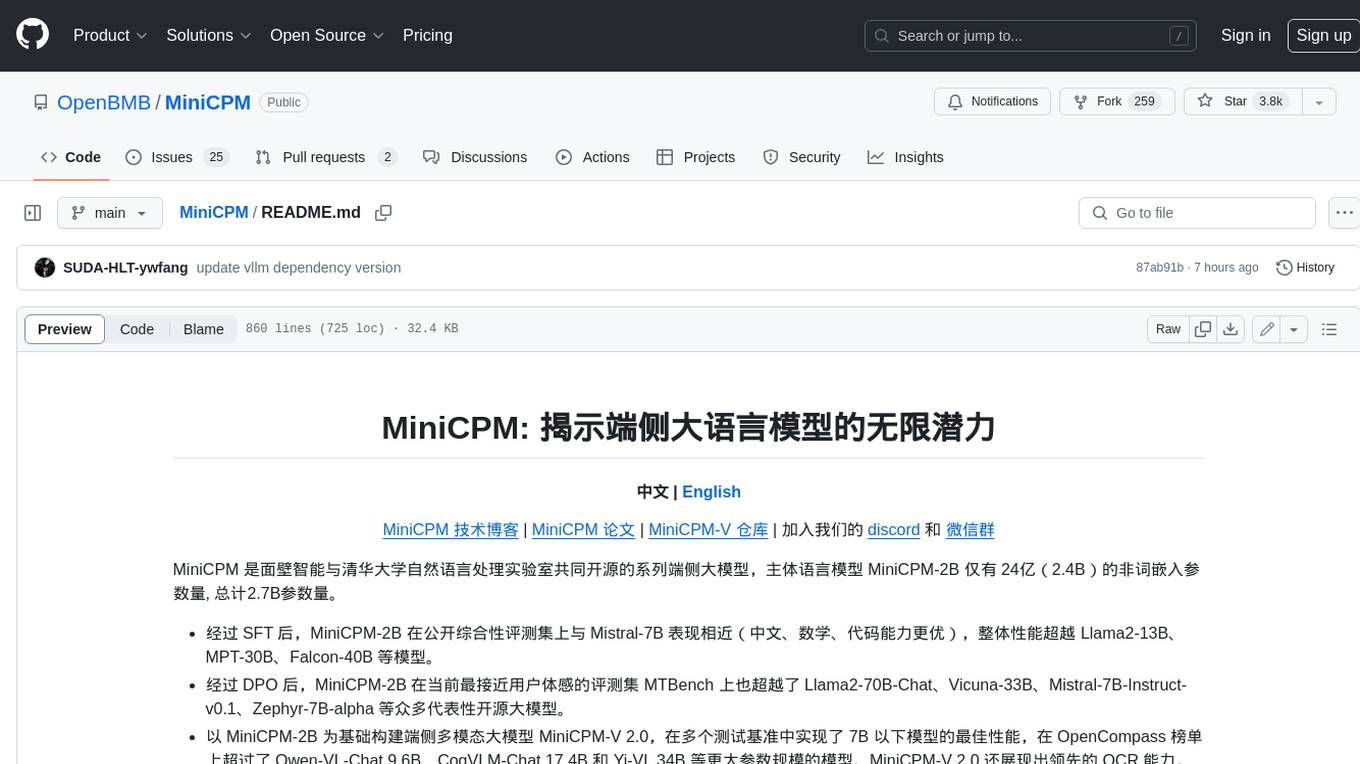
MiniCPM
MiniCPM is a series of open-source large models on the client side jointly developed by Face Intelligence and Tsinghua University Natural Language Processing Laboratory. The main language model MiniCPM-2B has only 2.4 billion (2.4B) non-word embedding parameters, with a total of 2.7B parameters. - After SFT, MiniCPM-2B performs similarly to Mistral-7B on public comprehensive evaluation sets (better in Chinese, mathematics, and code capabilities), and outperforms models such as Llama2-13B, MPT-30B, and Falcon-40B overall. - After DPO, MiniCPM-2B also surpasses many representative open-source large models such as Llama2-70B-Chat, Vicuna-33B, Mistral-7B-Instruct-v0.1, and Zephyr-7B-alpha on the current evaluation set MTBench, which is closest to the user experience. - Based on MiniCPM-2B, a multi-modal large model MiniCPM-V 2.0 on the client side is constructed, which achieves the best performance of models below 7B in multiple test benchmarks, and surpasses larger parameter scale models such as Qwen-VL-Chat 9.6B, CogVLM-Chat 17.4B, and Yi-VL 34B on the OpenCompass leaderboard. MiniCPM-V 2.0 also demonstrates leading OCR capabilities, approaching Gemini Pro in scene text recognition capabilities. - After Int4 quantization, MiniCPM can be deployed and inferred on mobile phones, with a streaming output speed slightly higher than human speech speed. MiniCPM-V also directly runs through the deployment of multi-modal large models on mobile phones. - A single 1080/2080 can efficiently fine-tune parameters, and a single 3090/4090 can fully fine-tune parameters. A single machine can continuously train MiniCPM, and the secondary development cost is relatively low.
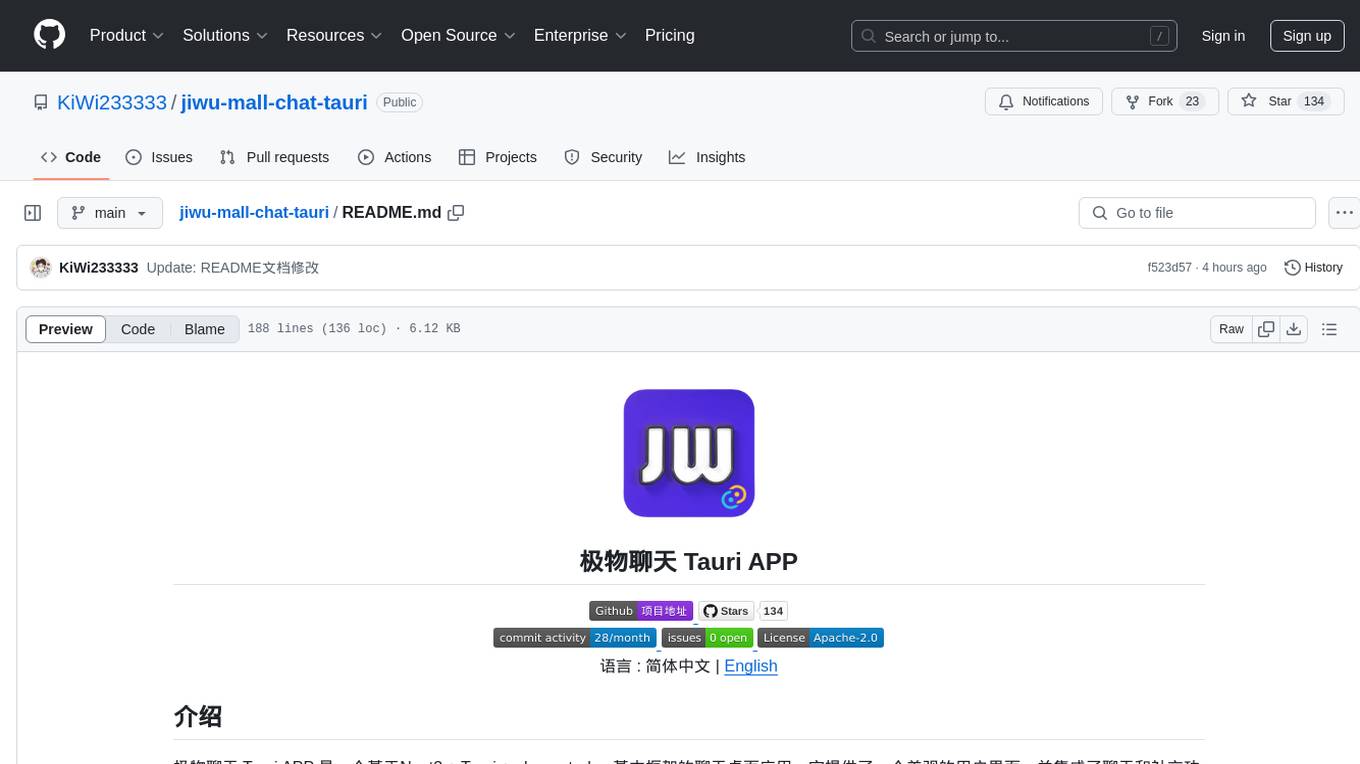
jiwu-mall-chat-tauri
Jiwu Chat Tauri APP is a desktop chat application based on Nuxt3 + Tauri + Element Plus framework. It provides a beautiful user interface with integrated chat and social functions. It also supports AI shopping chat and global dark mode. Users can engage in real-time chat, share updates, and interact with AI customer service through this application.
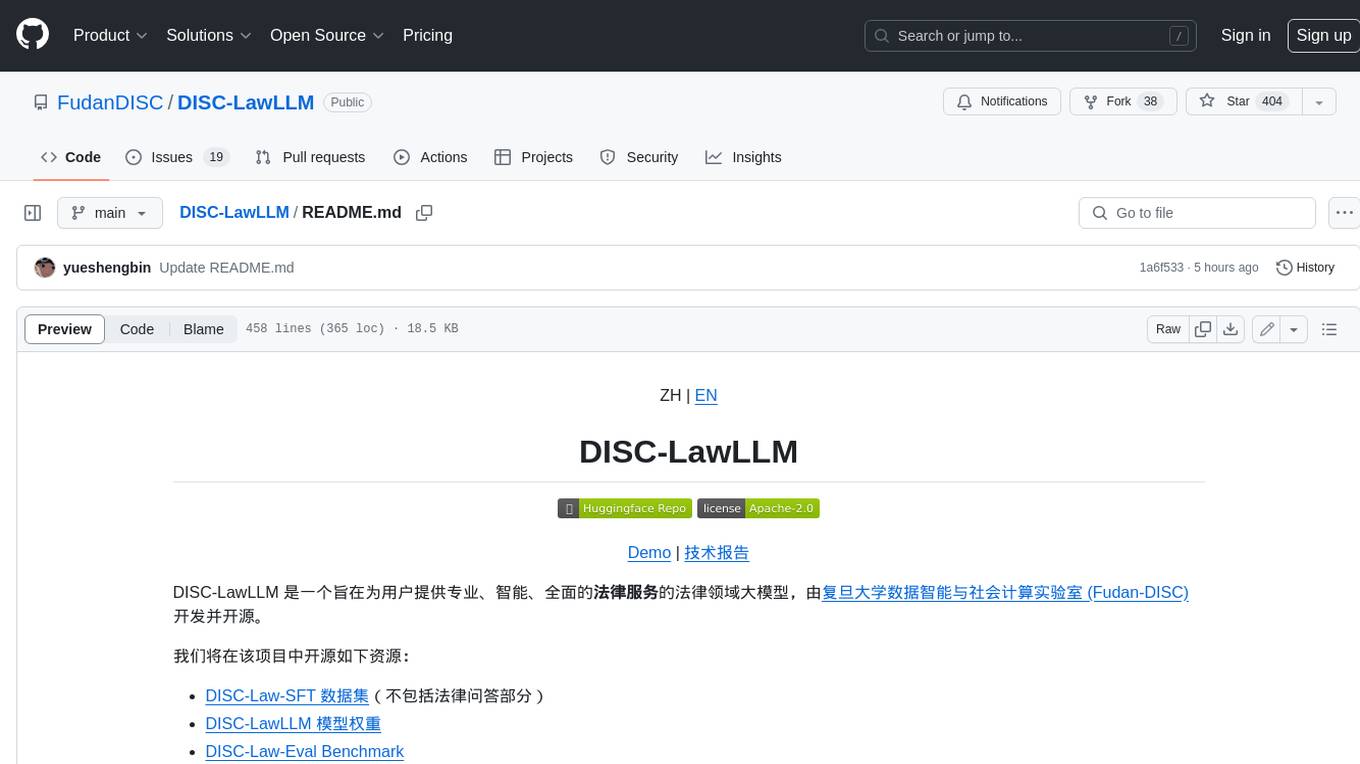
DISC-LawLLM
DISC-LawLLM is a legal domain large model that aims to provide professional, intelligent, and comprehensive **legal services** to users. It is developed and open-sourced by the Data Intelligence and Social Computing Lab (Fudan-DISC) at Fudan University.
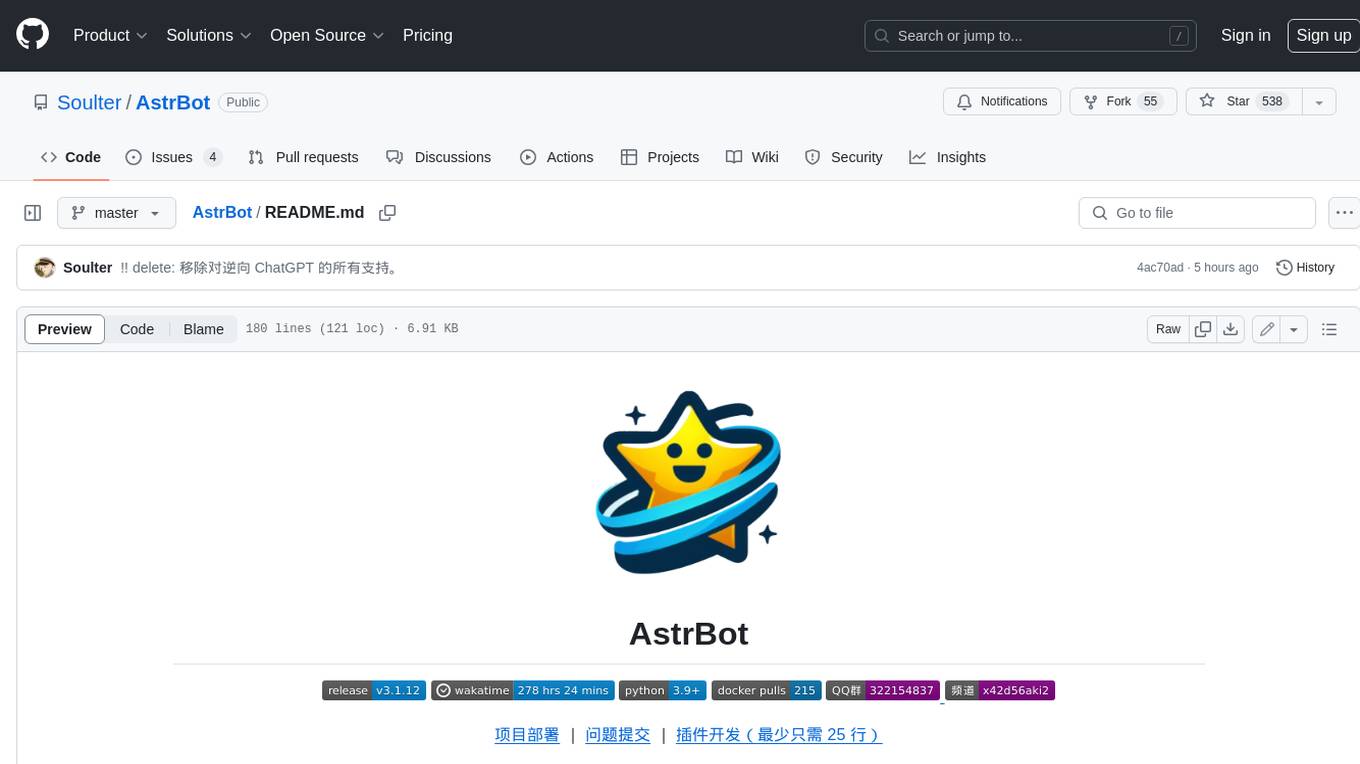
AstrBot
AstrBot is a powerful and versatile tool that leverages the capabilities of large language models (LLMs) like GPT-3, GPT-3.5, and GPT-4 to enhance communication and automate tasks. It seamlessly integrates with popular messaging platforms such as QQ, QQ Channel, and Telegram, enabling users to harness the power of AI within their daily conversations and workflows.
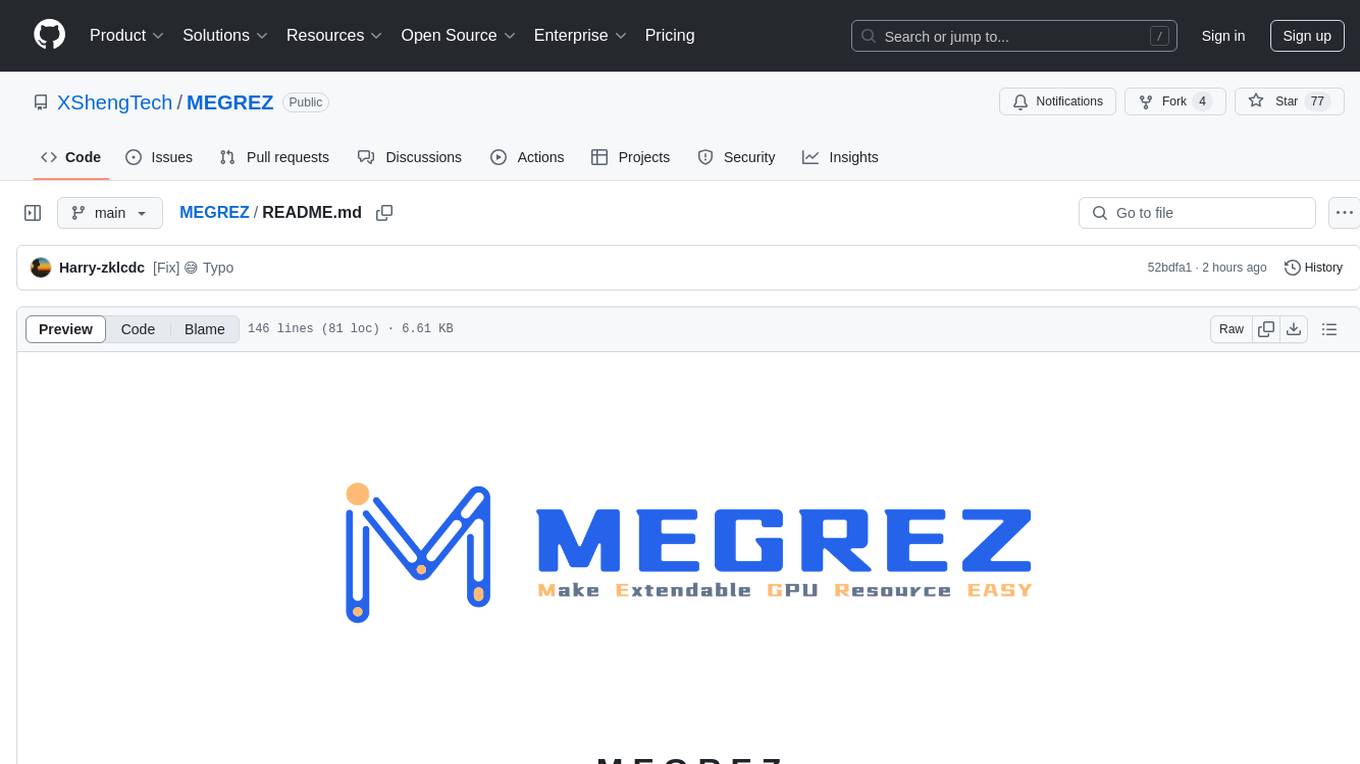
MEGREZ
MEGREZ is a modern and elegant open-source high-performance computing platform that efficiently manages GPU resources. It allows for easy container instance creation, supports multiple nodes/multiple GPUs, modern UI environment isolation, customizable performance configurations, and user data isolation. The platform also comes with pre-installed deep learning environments, supports multiple users, features a VSCode web version, resource performance monitoring dashboard, and Jupyter Notebook support.
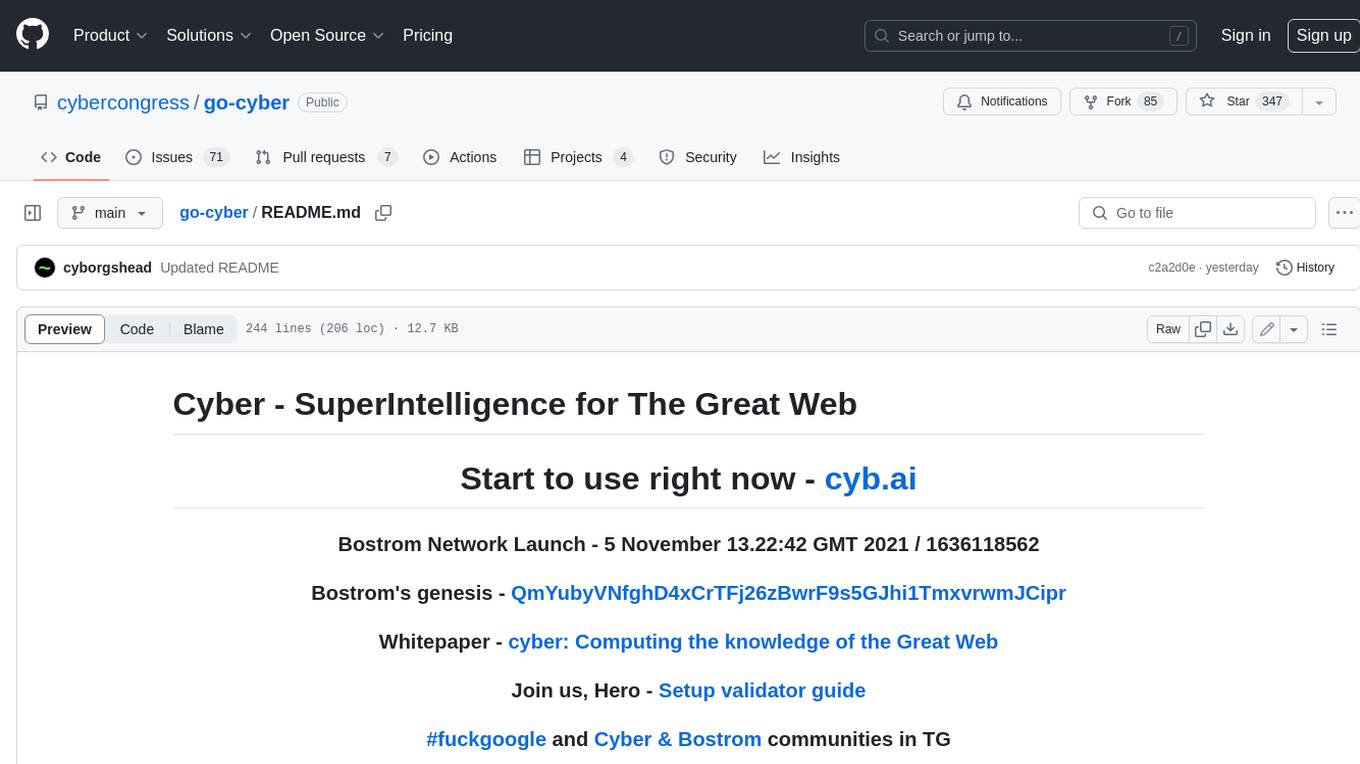
go-cyber
Cyber is a superintelligence protocol that aims to create a decentralized and censorship-resistant internet. It uses a novel consensus mechanism called CometBFT and a knowledge graph to store and process information. Cyber is designed to be scalable, secure, and efficient, and it has the potential to revolutionize the way we interact with the internet.
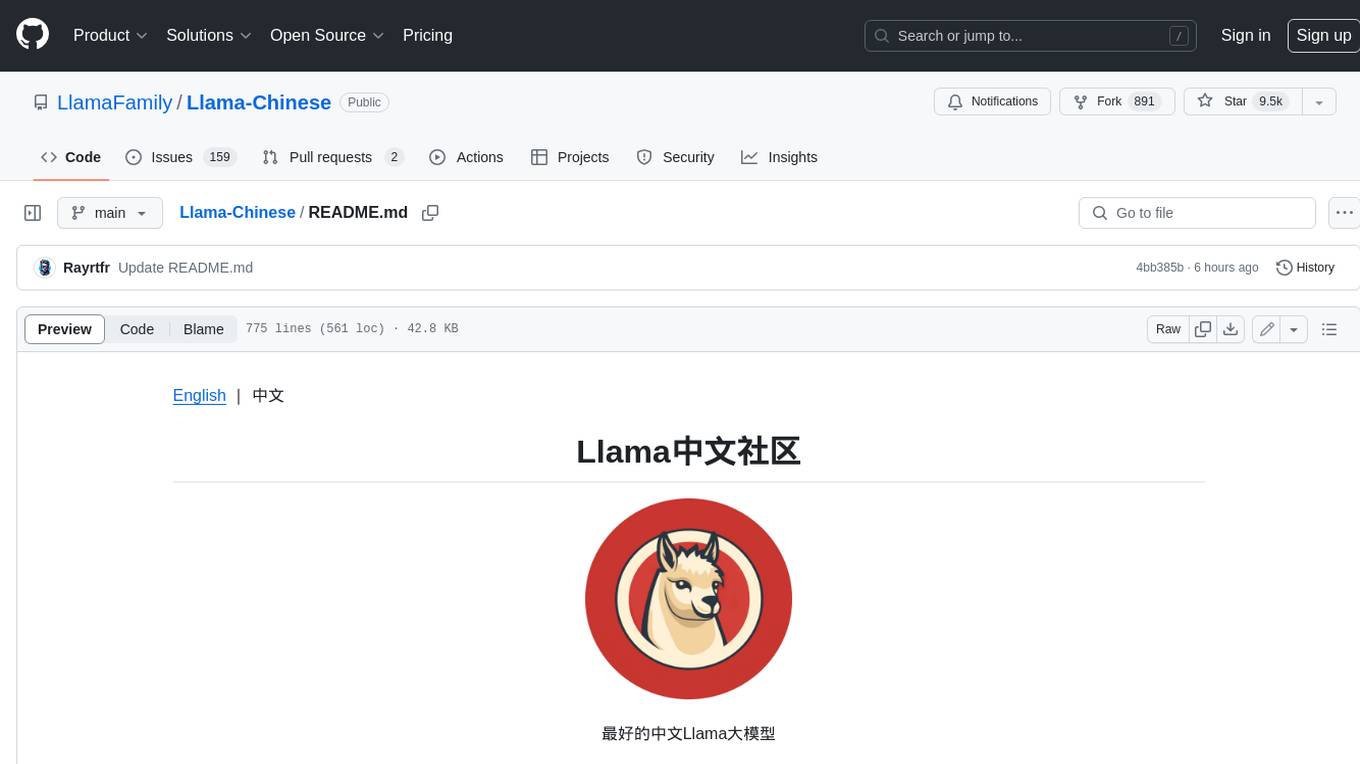
Llama-Chinese
Llama中文社区是一个专注于Llama模型在中文方面的优化和上层建设的高级技术社区。 **已经基于大规模中文数据,从预训练开始对Llama2模型进行中文能力的持续迭代升级【Done】**。**正在对Llama3模型进行中文能力的持续迭代升级【Doing】** 我们热忱欢迎对大模型LLM充满热情的开发者和研究者加入我们的行列。
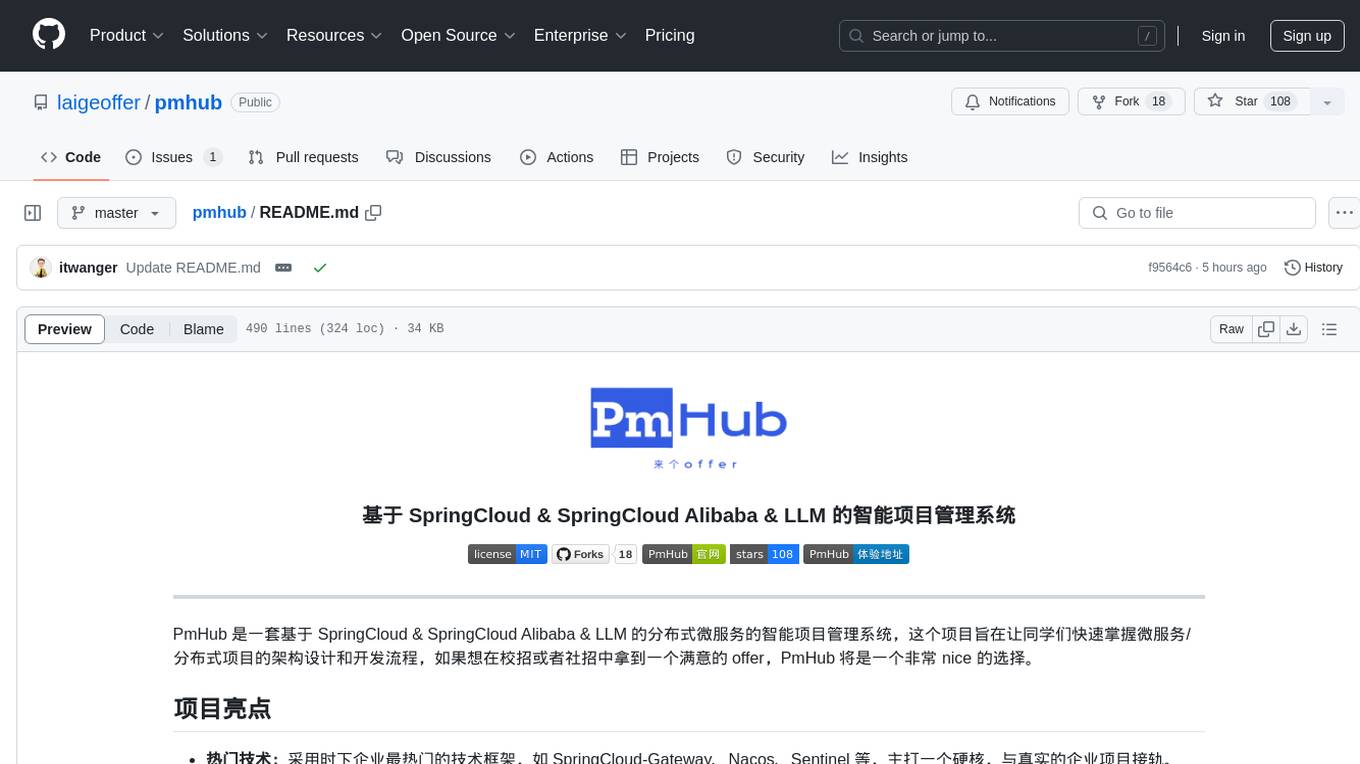
pmhub
PmHub is a smart project management system based on SpringCloud, SpringCloud Alibaba, and LLM. It aims to help students quickly grasp the architecture design and development process of microservices/distributed projects. PmHub provides a platform for students to experience the transformation from monolithic to microservices architecture, understand the pros and cons of both architectures, and prepare for job interviews. It offers popular technologies like SpringCloud-Gateway, Nacos, Sentinel, and provides high-quality code, continuous integration, product design documents, and an enterprise workflow system. PmHub is suitable for beginners and advanced learners who want to master core knowledge of microservices/distributed projects.
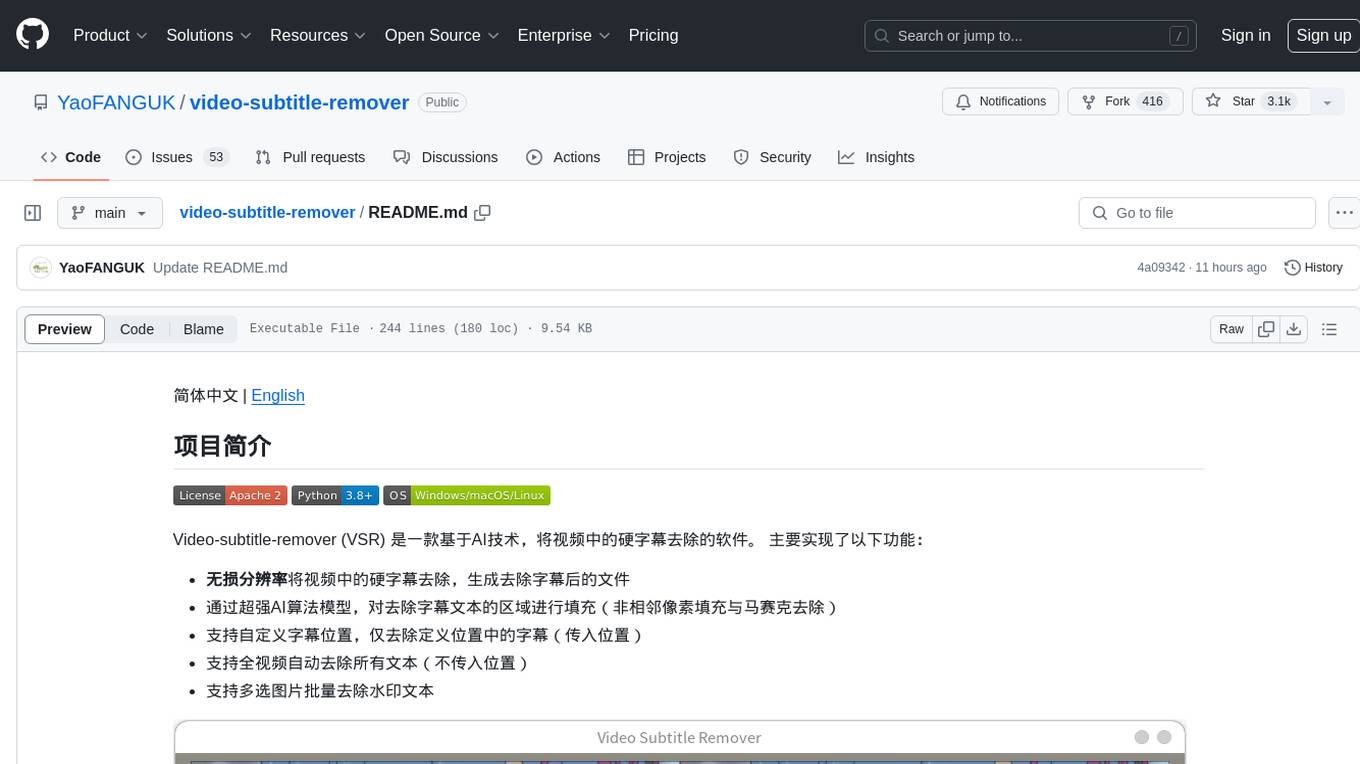
video-subtitle-remover
Video-subtitle-remover (VSR) is a software based on AI technology that removes hard subtitles from videos. It achieves the following functions: - Lossless resolution: Remove hard subtitles from videos, generate files with subtitles removed - Fill the region of removed subtitles using a powerful AI algorithm model (non-adjacent pixel filling and mosaic removal) - Support custom subtitle positions, only remove subtitles in defined positions (input position) - Support automatic removal of all text in the entire video (no input position required) - Support batch removal of watermark text from multiple images.
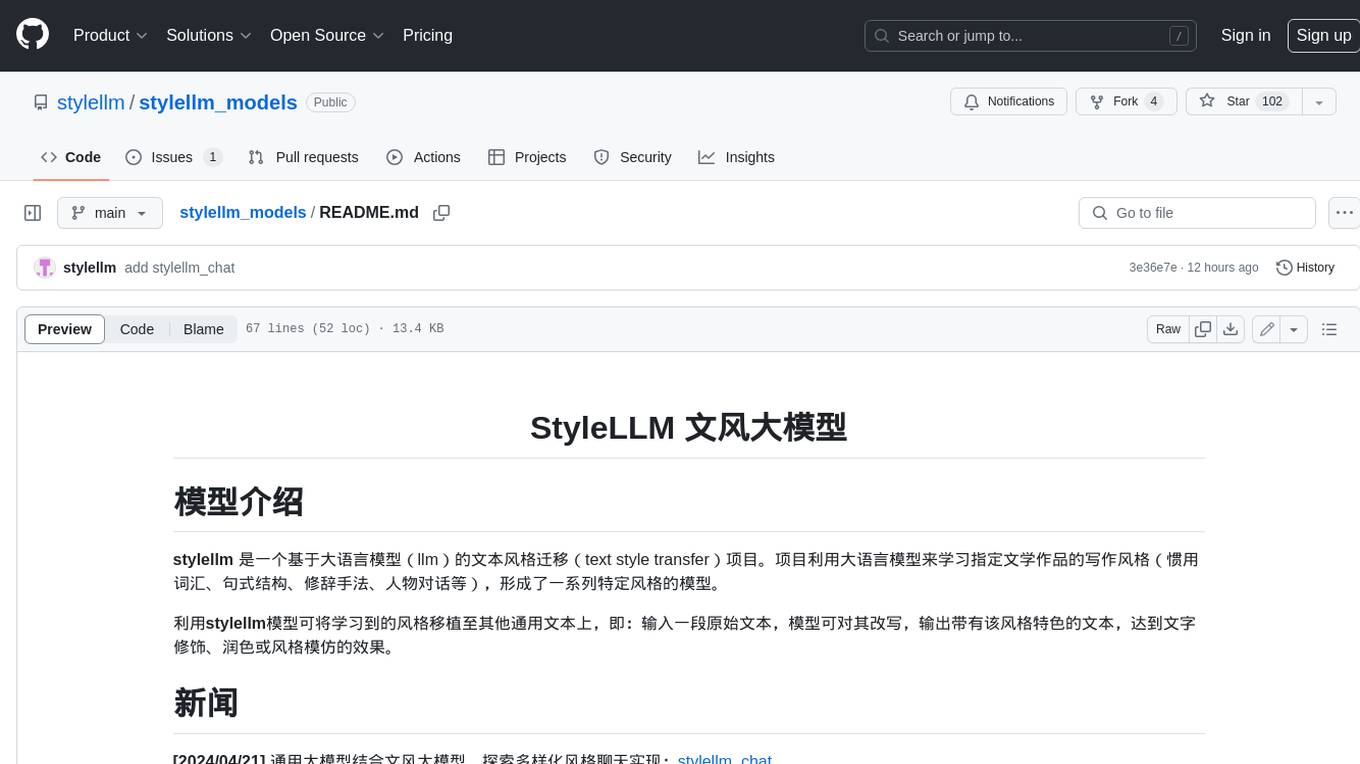
stylellm_models
**stylellm** is a text style transfer project based on large language models (llms). The project utilizes large language models to learn the writing style of specific literary works (commonly used vocabulary, sentence structure, rhetoric, character dialogue, etc.), forming a series of specific style models. Using the **stylellm** model, the learned style can be transferred to other general texts, that is: input a piece of original text, the model can rewrite it, output text with the characteristics of that style, achieving the effect of text modification,润色or style imitation.
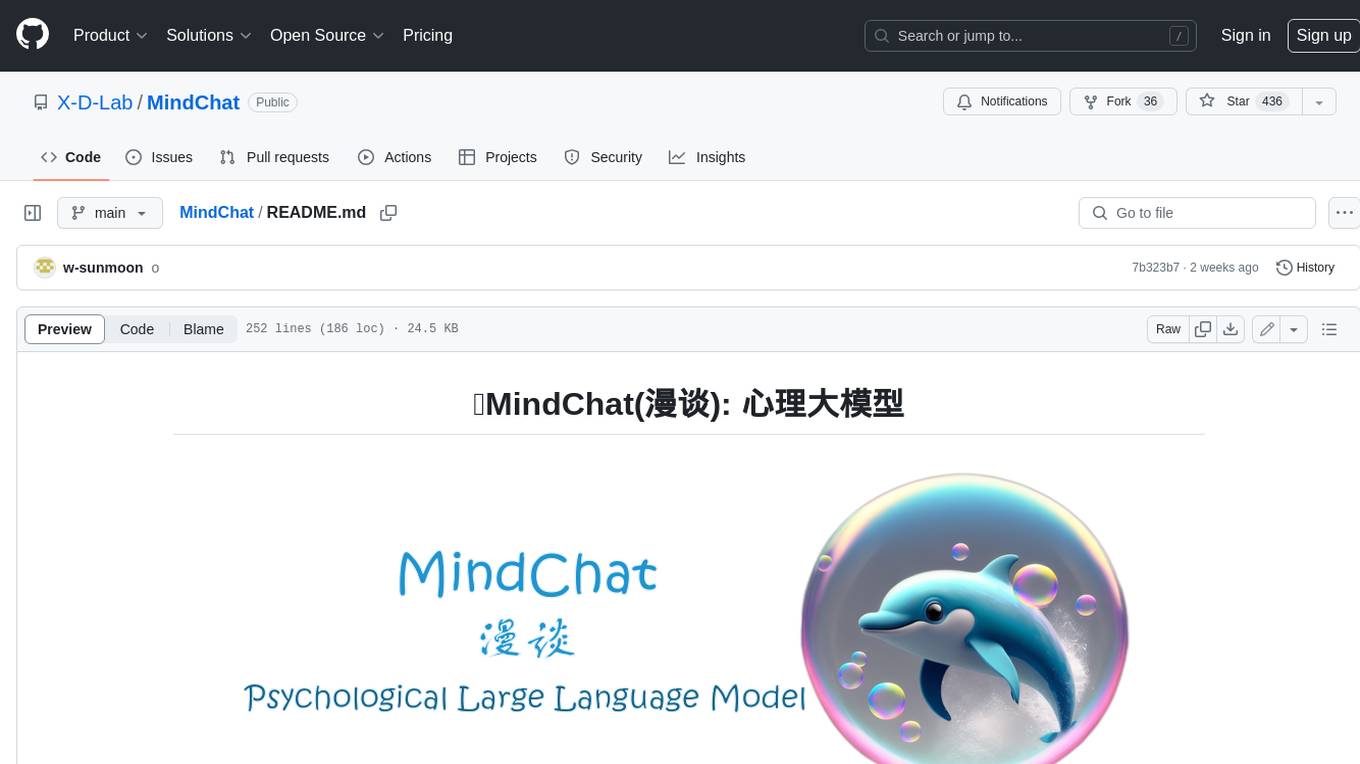
MindChat
MindChat is a psychological large language model designed to help individuals relieve psychological stress and solve mental confusion, ultimately improving mental health. It aims to provide a relaxed and open conversation environment for users to build trust and understanding. MindChat offers privacy, warmth, safety, timely, and convenient conversation settings to help users overcome difficulties and challenges, achieve self-growth, and development. The tool is suitable for both work and personal life scenarios, providing comprehensive psychological support and therapeutic assistance to users while strictly protecting user privacy. It combines psychological knowledge with artificial intelligence technology to contribute to a healthier, more inclusive, and equal society.
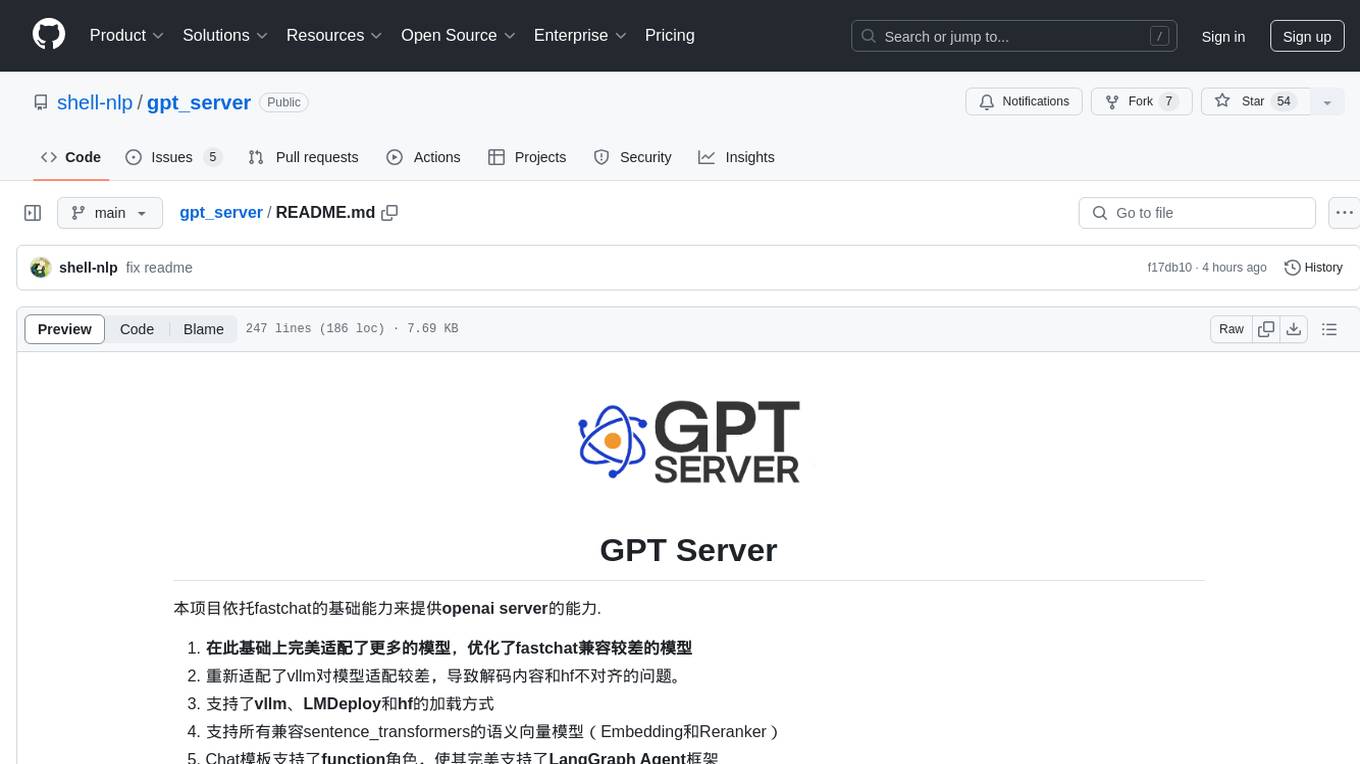
gpt_server
The GPT Server project leverages the basic capabilities of FastChat to provide the capabilities of an openai server. It perfectly adapts more models, optimizes models with poor compatibility in FastChat, and supports loading vllm, LMDeploy, and hf in various ways. It also supports all sentence_transformers compatible semantic vector models, including Chat templates with function roles, Function Calling (Tools) capability, and multi-modal large models. The project aims to reduce the difficulty of model adaptation and project usage, making it easier to deploy the latest models with minimal code changes.
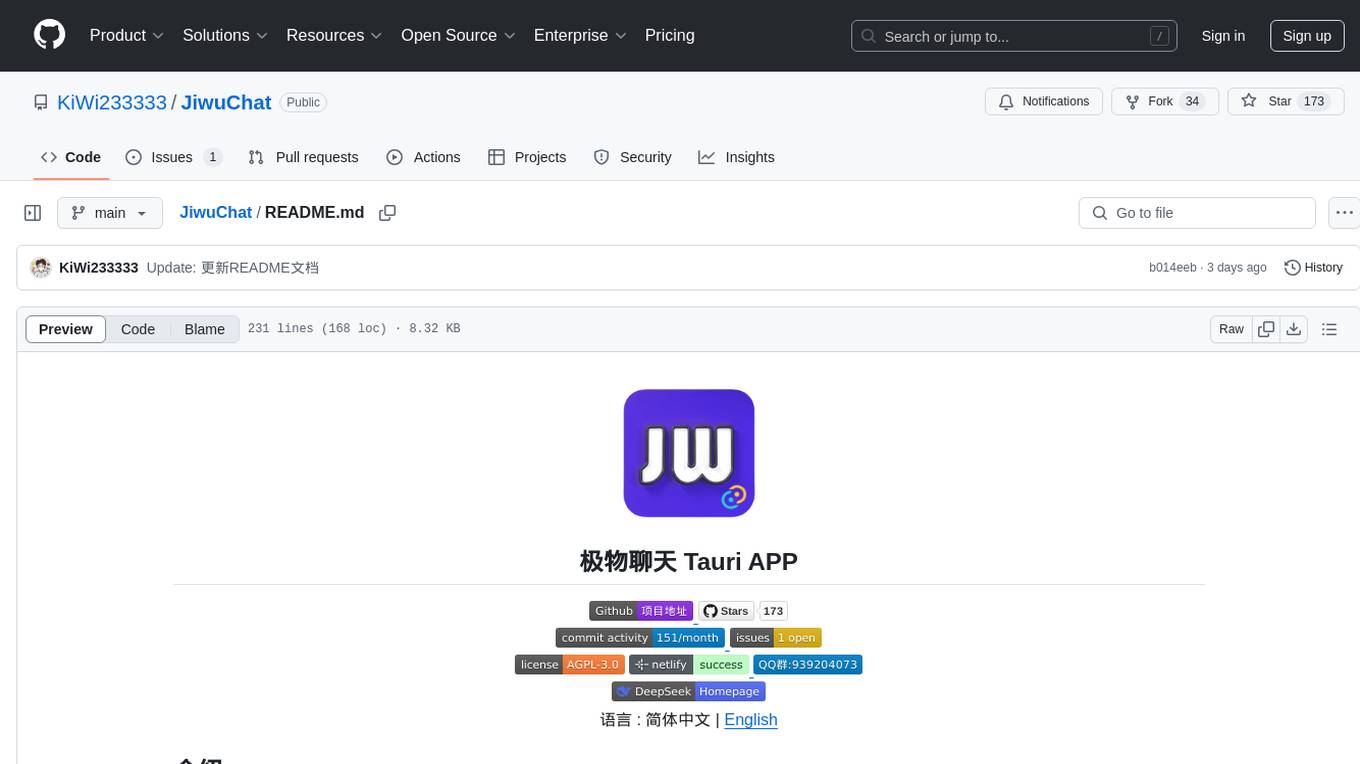
JiwuChat
JiwuChat is a lightweight multi-platform chat application built on Tauri2 and Nuxt3, with various real-time messaging features, AI group chat bots (such as 'iFlytek Spark', 'KimiAI' etc.), WebRTC audio-video calling, screen sharing, and AI shopping functions. It supports seamless cross-device communication, covering text, images, files, and voice messages, also supporting group chats and customizable settings. It provides light/dark mode for efficient social networking.
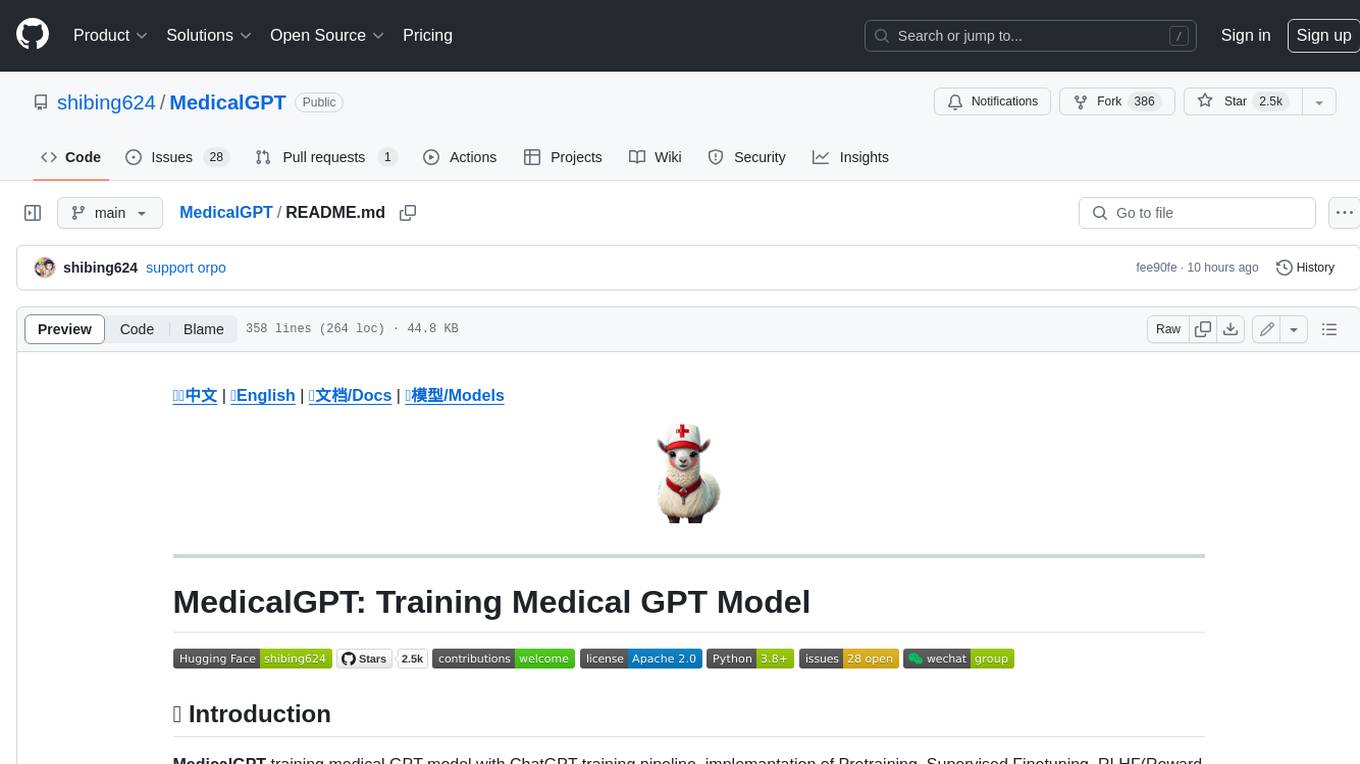
MedicalGPT
MedicalGPT is a training medical GPT model with ChatGPT training pipeline, implement of Pretraining, Supervised Finetuning, RLHF(Reward Modeling and Reinforcement Learning) and DPO(Direct Preference Optimization).
For similar tasks

wenda
Wenda is a platform for large-scale language model invocation designed to efficiently generate content for specific environments, considering the limitations of personal and small business computing resources, as well as knowledge security and privacy issues. The platform integrates capabilities such as knowledge base integration, multiple large language models for offline deployment, auto scripts for additional functionality, and other practical capabilities like conversation history management and multi-user simultaneous usage.

kaito
Kaito is an operator that automates the AI/ML inference model deployment in a Kubernetes cluster. It manages large model files using container images, avoids tuning deployment parameters to fit GPU hardware by providing preset configurations, auto-provisions GPU nodes based on model requirements, and hosts large model images in the public Microsoft Container Registry (MCR) if the license allows. Using Kaito, the workflow of onboarding large AI inference models in Kubernetes is largely simplified.

griptape
Griptape is a modular Python framework for building AI-powered applications that securely connect to your enterprise data and APIs. It offers developers the ability to maintain control and flexibility at every step. Griptape's core components include Structures (Agents, Pipelines, and Workflows), Tasks, Tools, Memory (Conversation Memory, Task Memory, and Meta Memory), Drivers (Prompt and Embedding Drivers, Vector Store Drivers, Image Generation Drivers, Image Query Drivers, SQL Drivers, Web Scraper Drivers, and Conversation Memory Drivers), Engines (Query Engines, Extraction Engines, Summary Engines, Image Generation Engines, and Image Query Engines), and additional components (Rulesets, Loaders, Artifacts, Chunkers, and Tokenizers). Griptape enables developers to create AI-powered applications with ease and efficiency.

zep-python
Zep is an open-source platform for building and deploying large language model (LLM) applications. It provides a suite of tools and services that make it easy to integrate LLMs into your applications, including chat history memory, embedding, vector search, and data enrichment. Zep is designed to be scalable, reliable, and easy to use, making it a great choice for developers who want to build LLM-powered applications quickly and easily.
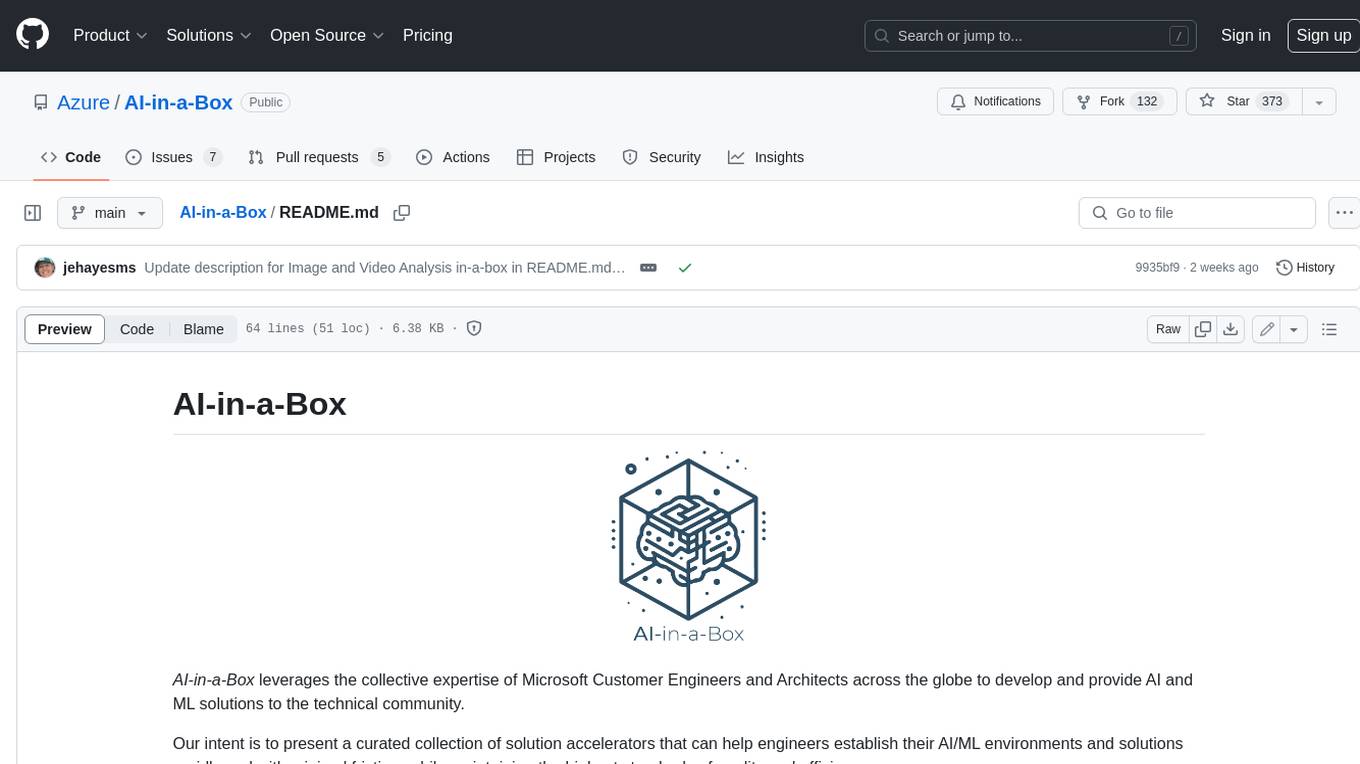
AI-in-a-Box
AI-in-a-Box is a curated collection of solution accelerators that can help engineers establish their AI/ML environments and solutions rapidly and with minimal friction, while maintaining the highest standards of quality and efficiency. It provides essential guidance on the responsible use of AI and LLM technologies, specific security guidance for Generative AI (GenAI) applications, and best practices for scaling OpenAI applications within Azure. The available accelerators include: Azure ML Operationalization in-a-box, Edge AI in-a-box, Doc Intelligence in-a-box, Image and Video Analysis in-a-box, Cognitive Services Landing Zone in-a-box, Semantic Kernel Bot in-a-box, NLP to SQL in-a-box, Assistants API in-a-box, and Assistants API Bot in-a-box.
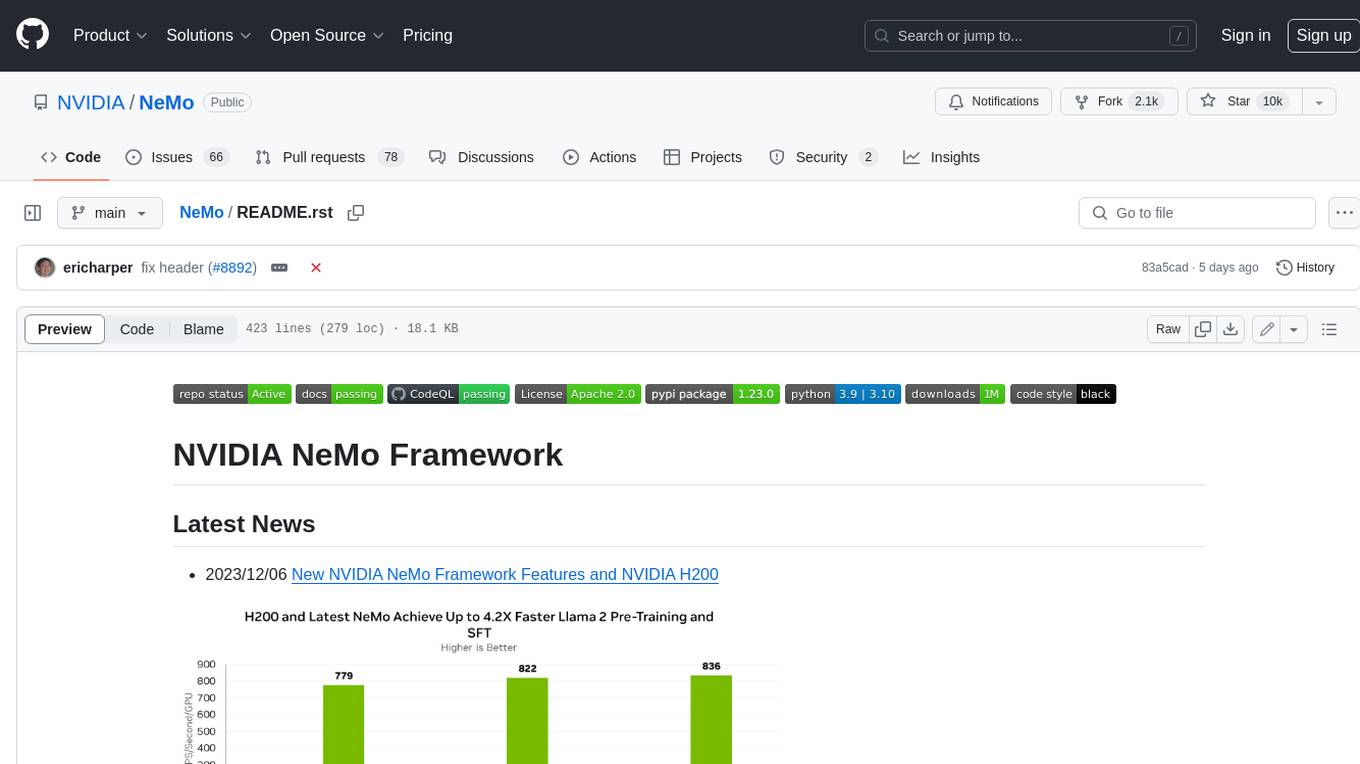
NeMo
NeMo Framework is a generative AI framework built for researchers and pytorch developers working on large language models (LLMs), multimodal models (MM), automatic speech recognition (ASR), and text-to-speech synthesis (TTS). The primary objective of NeMo is to provide a scalable framework for researchers and developers from industry and academia to more easily implement and design new generative AI models by being able to leverage existing code and pretrained models.
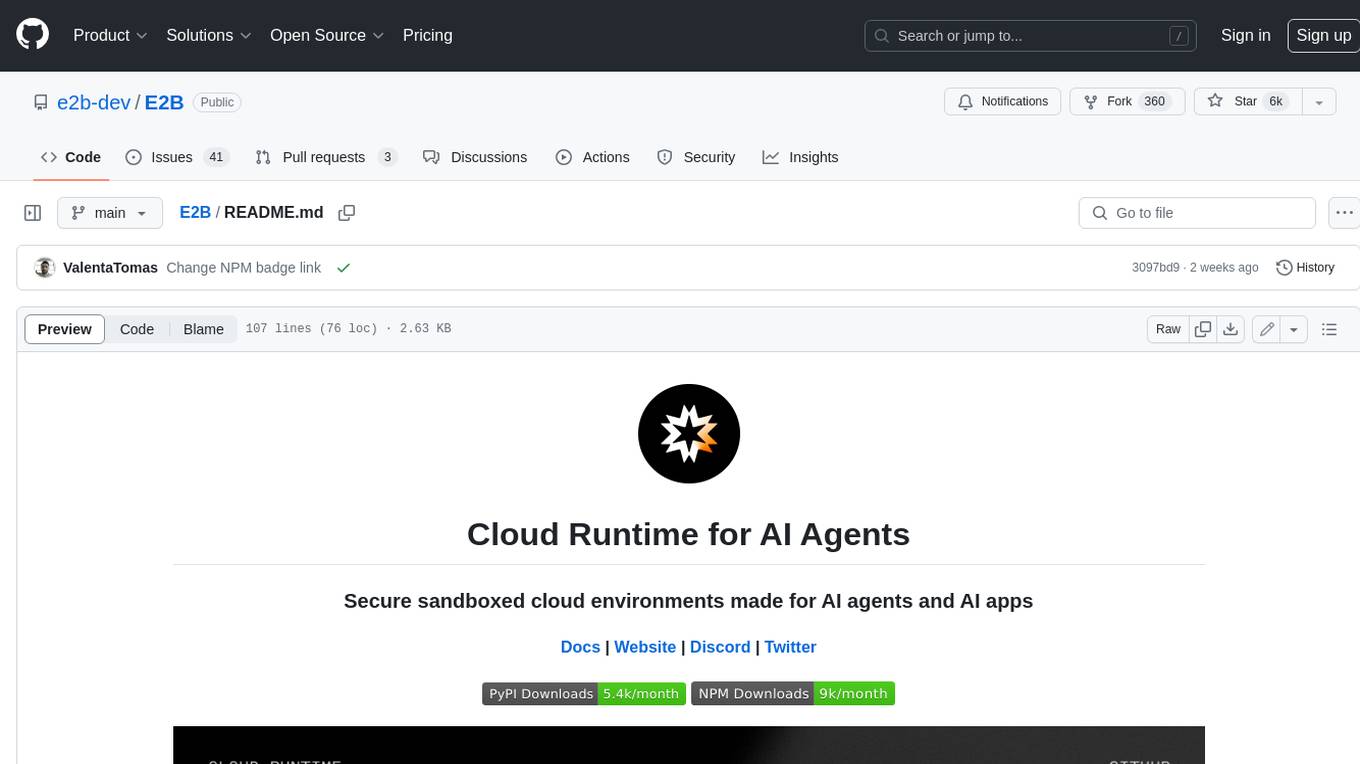
E2B
E2B Sandbox is a secure sandboxed cloud environment made for AI agents and AI apps. Sandboxes allow AI agents and apps to have long running cloud secure environments. In these environments, large language models can use the same tools as humans do. For example: * Cloud browsers * GitHub repositories and CLIs * Coding tools like linters, autocomplete, "go-to defintion" * Running LLM generated code * Audio & video editing The E2B sandbox can be connected to any LLM and any AI agent or app.
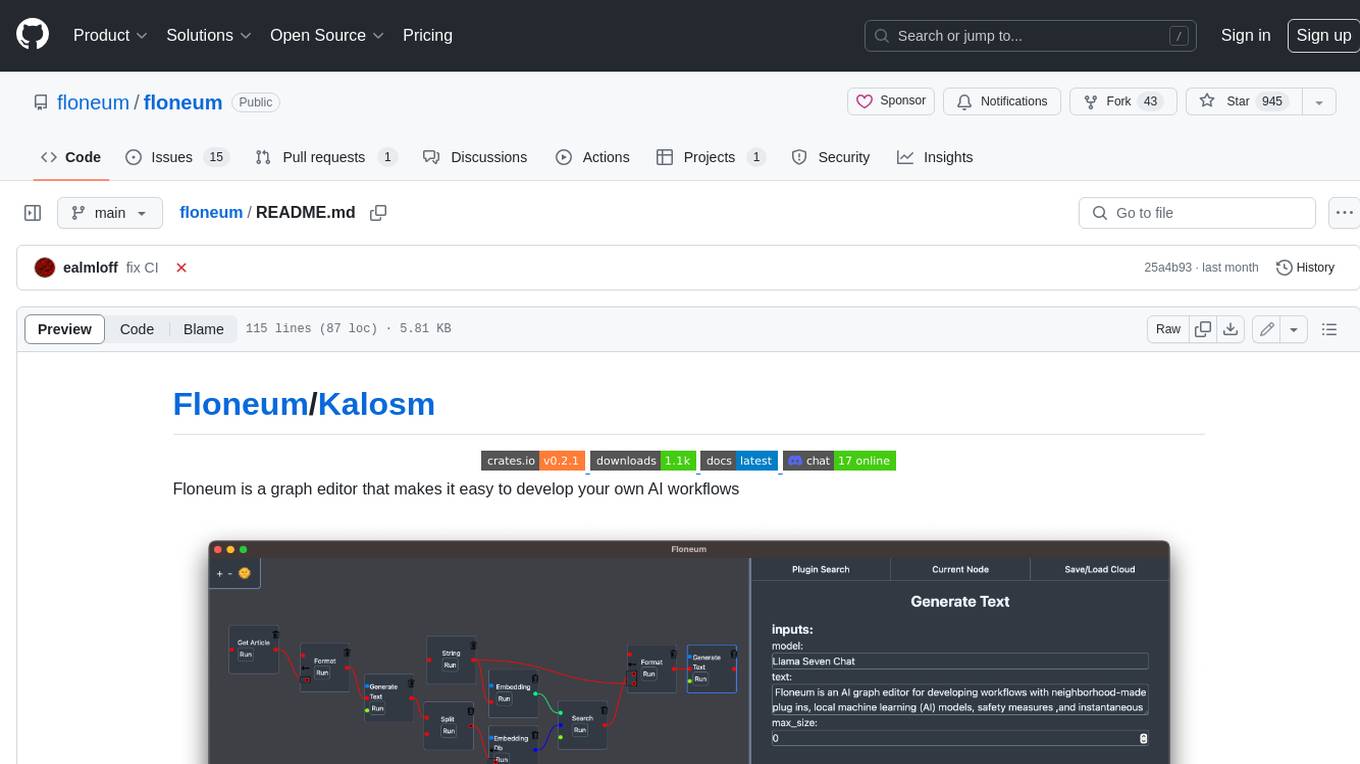
floneum
Floneum is a graph editor that makes it easy to develop your own AI workflows. It uses large language models (LLMs) to run AI models locally, without any external dependencies or even a GPU. This makes it easy to use LLMs with your own data, without worrying about privacy. Floneum also has a plugin system that allows you to improve the performance of LLMs and make them work better for your specific use case. Plugins can be used in any language that supports web assembly, and they can control the output of LLMs with a process similar to JSONformer or guidance.
For similar jobs
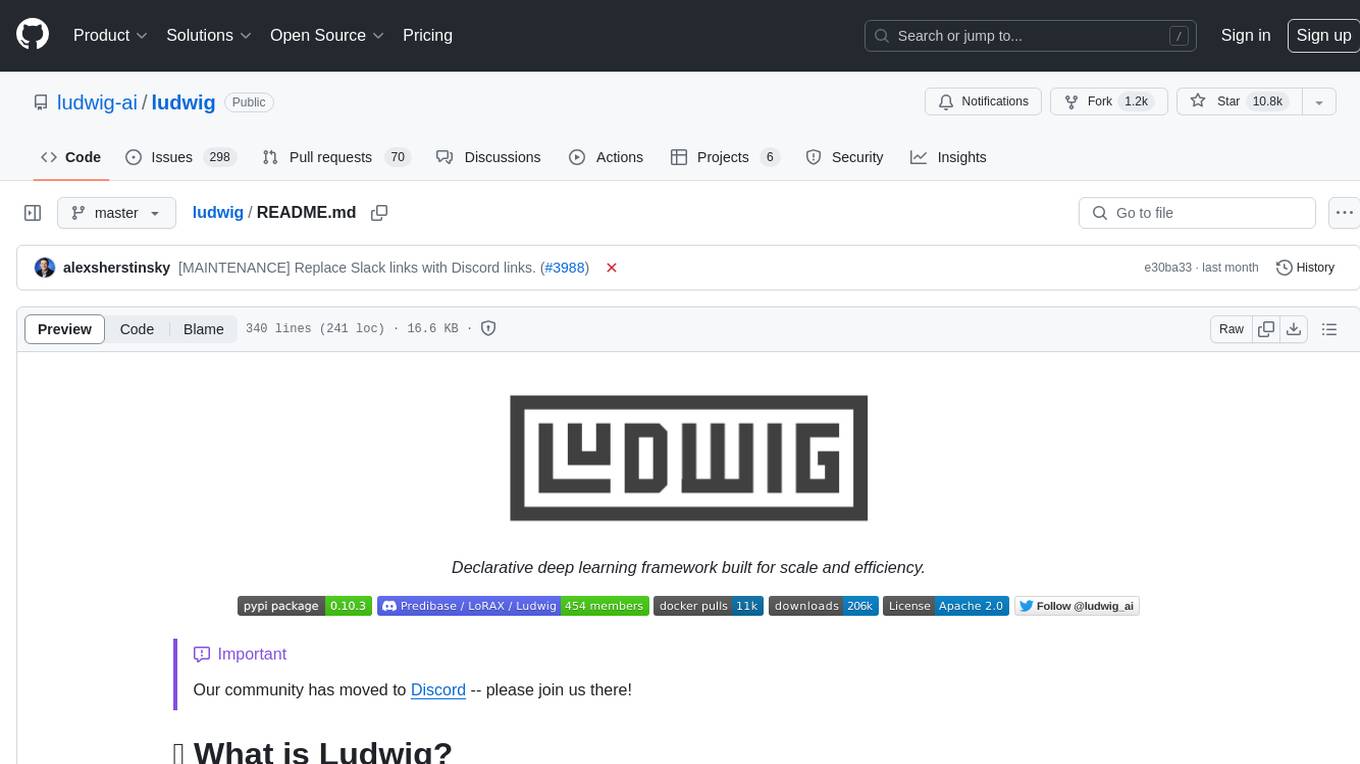
ludwig
Ludwig is a declarative deep learning framework designed for scale and efficiency. It is a low-code framework that allows users to build custom AI models like LLMs and other deep neural networks with ease. Ludwig offers features such as optimized scale and efficiency, expert level control, modularity, and extensibility. It is engineered for production with prebuilt Docker containers, support for running with Ray on Kubernetes, and the ability to export models to Torchscript and Triton. Ludwig is hosted by the Linux Foundation AI & Data.

wenda
Wenda is a platform for large-scale language model invocation designed to efficiently generate content for specific environments, considering the limitations of personal and small business computing resources, as well as knowledge security and privacy issues. The platform integrates capabilities such as knowledge base integration, multiple large language models for offline deployment, auto scripts for additional functionality, and other practical capabilities like conversation history management and multi-user simultaneous usage.
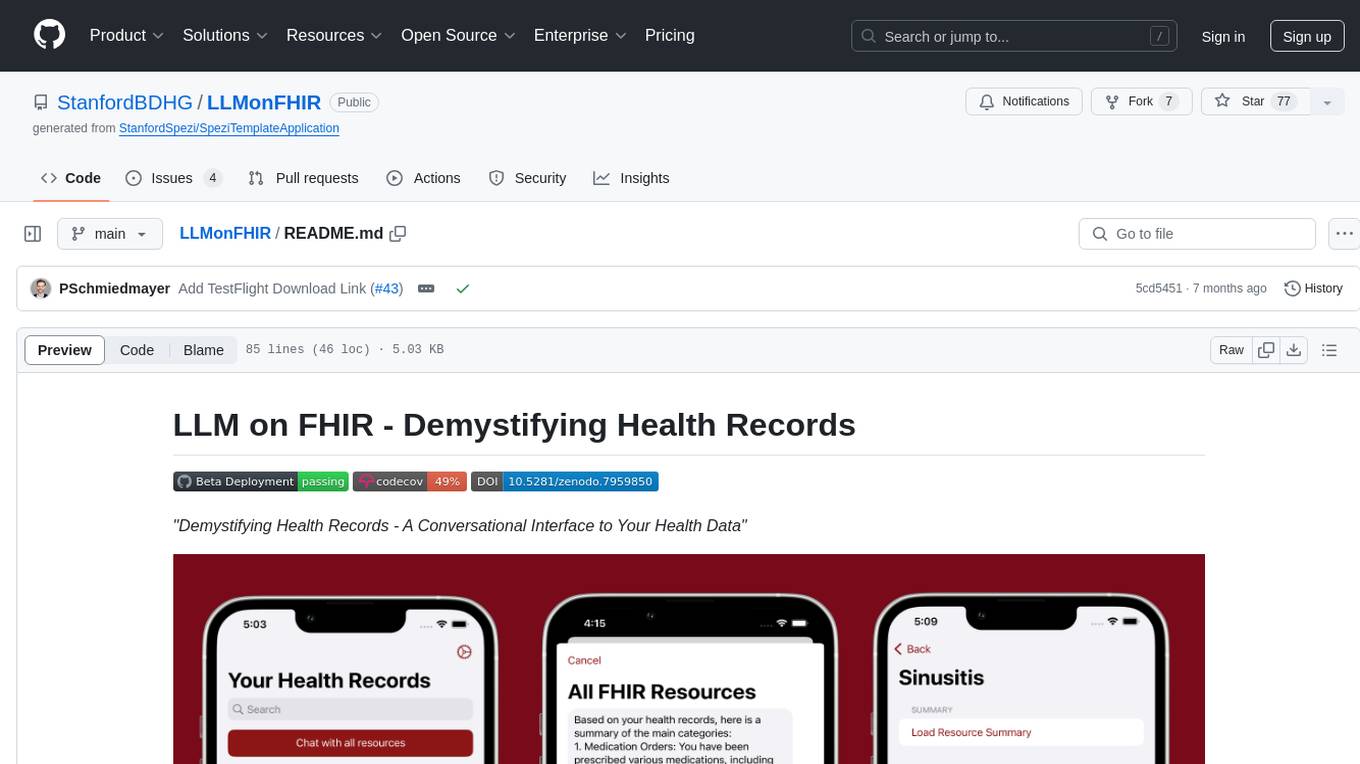
LLMonFHIR
LLMonFHIR is an iOS application that utilizes large language models (LLMs) to interpret and provide context around patient data in the Fast Healthcare Interoperability Resources (FHIR) format. It connects to the OpenAI GPT API to analyze FHIR resources, supports multiple languages, and allows users to interact with their health data stored in the Apple Health app. The app aims to simplify complex health records, provide insights, and facilitate deeper understanding through a conversational interface. However, it is an experimental app for informational purposes only and should not be used as a substitute for professional medical advice. Users are advised to verify information provided by AI models and consult healthcare professionals for personalized advice.
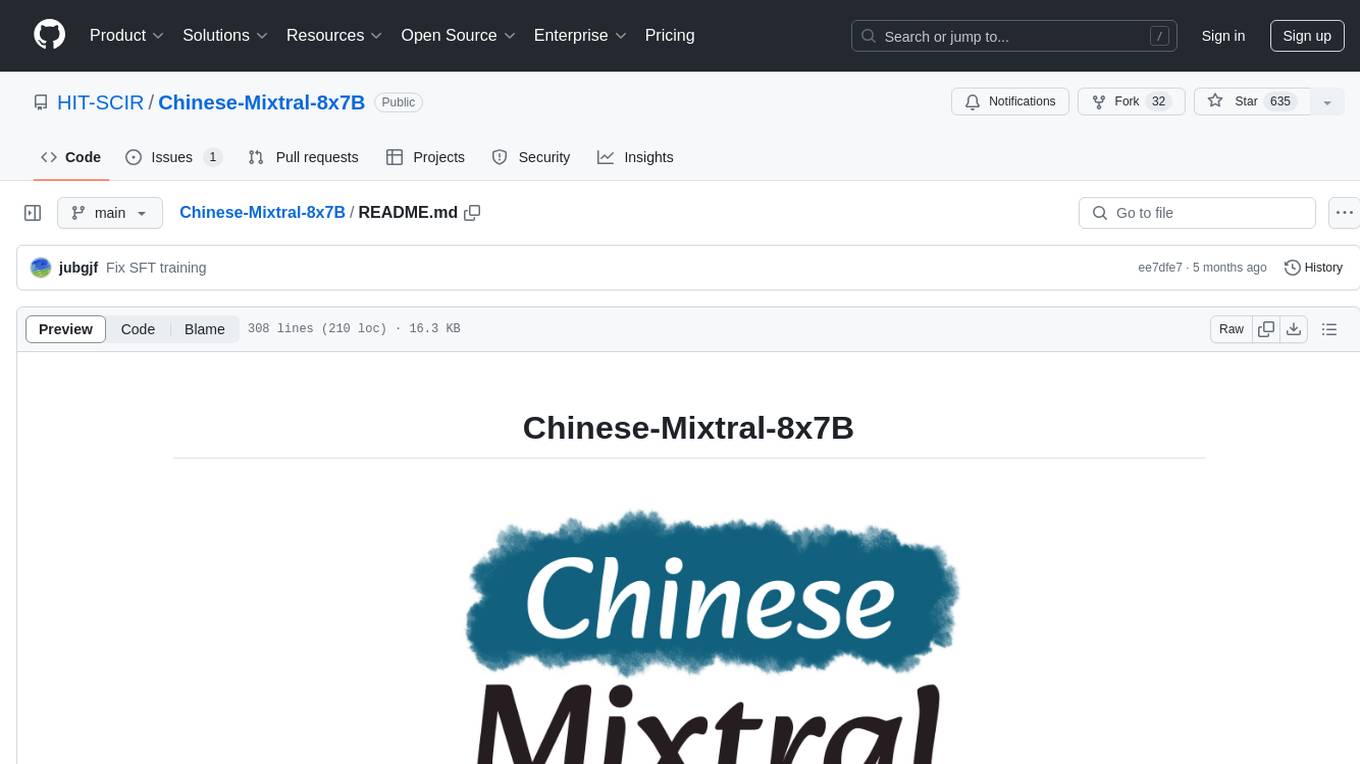
Chinese-Mixtral-8x7B
Chinese-Mixtral-8x7B is an open-source project based on Mistral's Mixtral-8x7B model for incremental pre-training of Chinese vocabulary, aiming to advance research on MoE models in the Chinese natural language processing community. The expanded vocabulary significantly improves the model's encoding and decoding efficiency for Chinese, and the model is pre-trained incrementally on a large-scale open-source corpus, enabling it with powerful Chinese generation and comprehension capabilities. The project includes a large model with expanded Chinese vocabulary and incremental pre-training code.
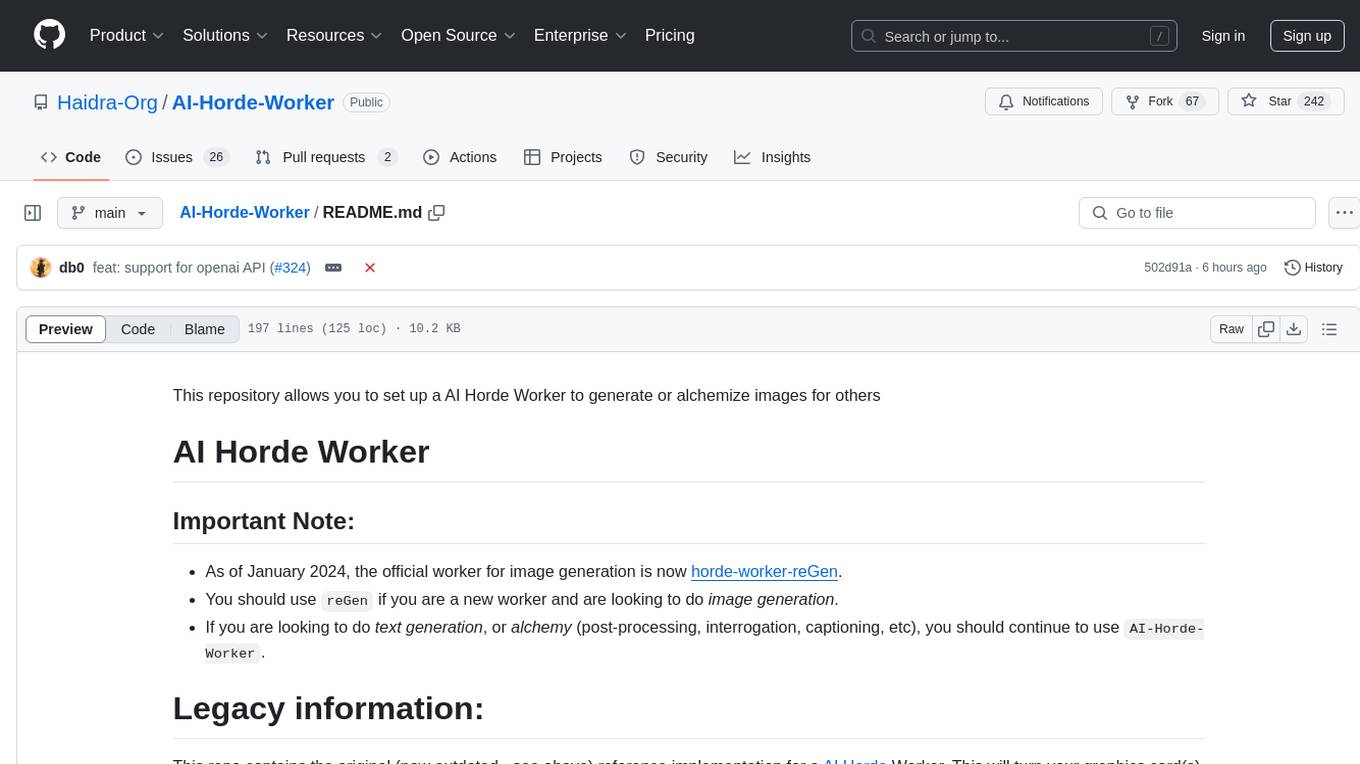
AI-Horde-Worker
AI-Horde-Worker is a repository containing the original reference implementation for a worker that turns your graphics card(s) into a worker for the AI Horde. It allows users to generate or alchemize images for others. The repository provides instructions for setting up the worker on Windows and Linux, updating the worker code, running with multiple GPUs, and stopping the worker. Users can configure the worker using a WebUI to connect to the horde with their username and API key. The repository also includes information on model usage and running the Docker container with specified environment variables.
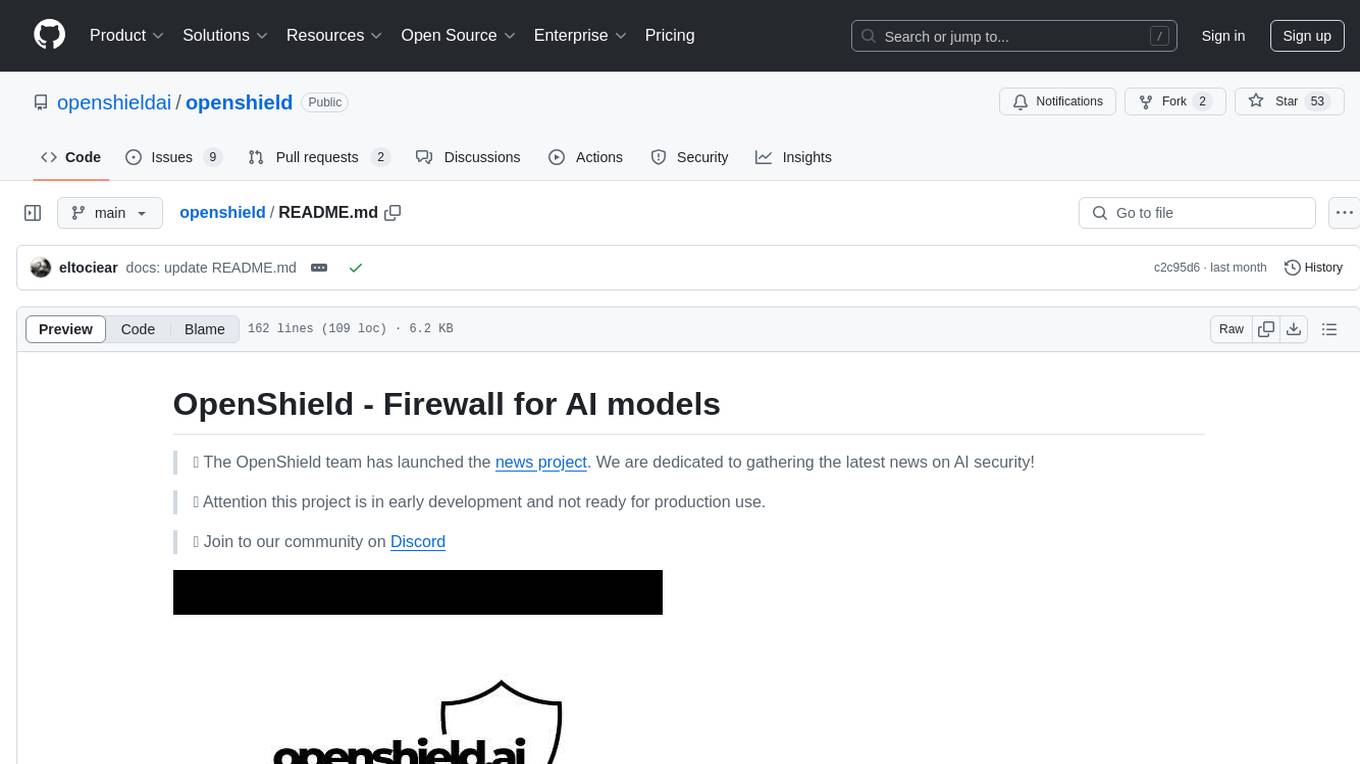
openshield
OpenShield is a firewall designed for AI models to protect against various attacks such as prompt injection, insecure output handling, training data poisoning, model denial of service, supply chain vulnerabilities, sensitive information disclosure, insecure plugin design, excessive agency granting, overreliance, and model theft. It provides rate limiting, content filtering, and keyword filtering for AI models. The tool acts as a transparent proxy between AI models and clients, allowing users to set custom rate limits for OpenAI endpoints and perform tokenizer calculations for OpenAI models. OpenShield also supports Python and LLM based rules, with upcoming features including rate limiting per user and model, prompts manager, content filtering, keyword filtering based on LLM/Vector models, OpenMeter integration, and VectorDB integration. The tool requires an OpenAI API key, Postgres, and Redis for operation.
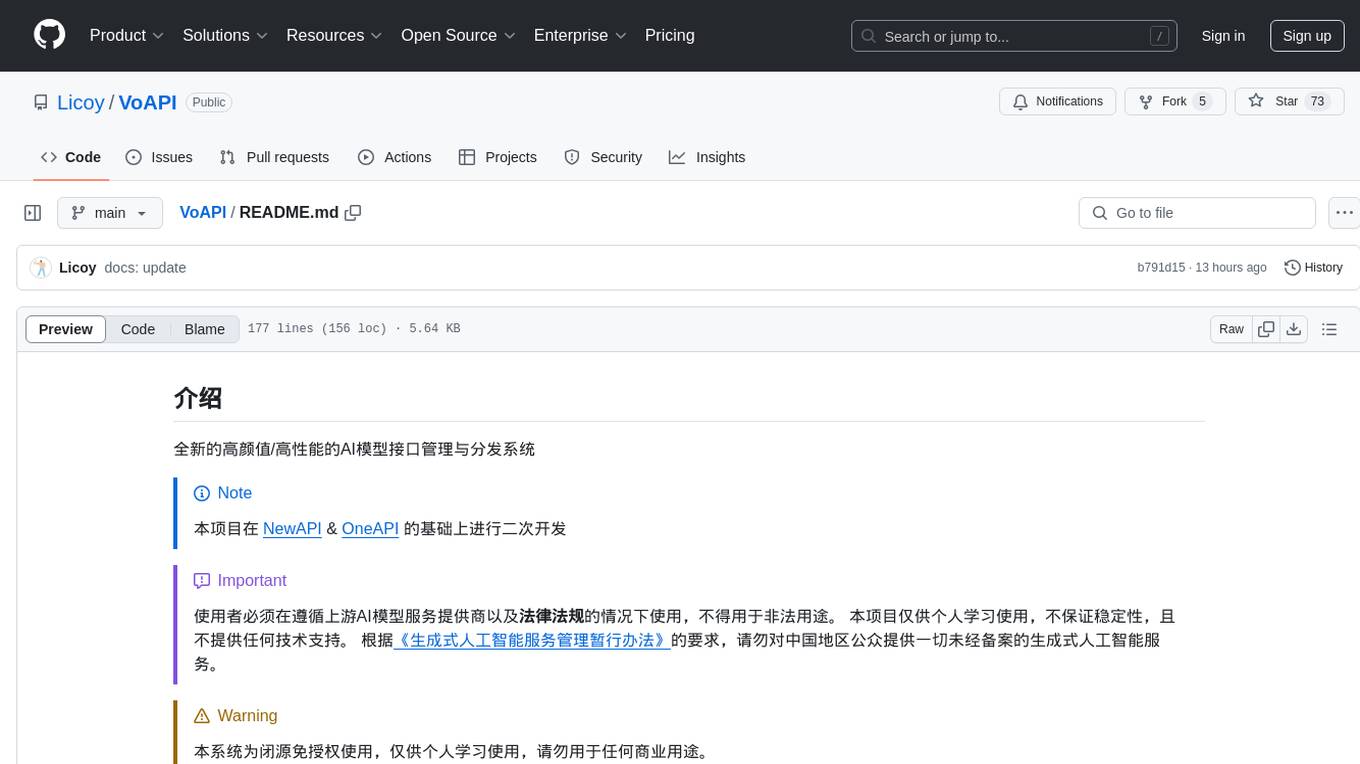
VoAPI
VoAPI is a new high-value/high-performance AI model interface management and distribution system. It is a closed-source tool for personal learning use only, not for commercial purposes. Users must comply with upstream AI model service providers and legal regulations. The system offers a visually appealing interface, independent development documentation page support, service monitoring page configuration support, and third-party login support. It also optimizes interface elements, user registration time support, data operation button positioning, and more.
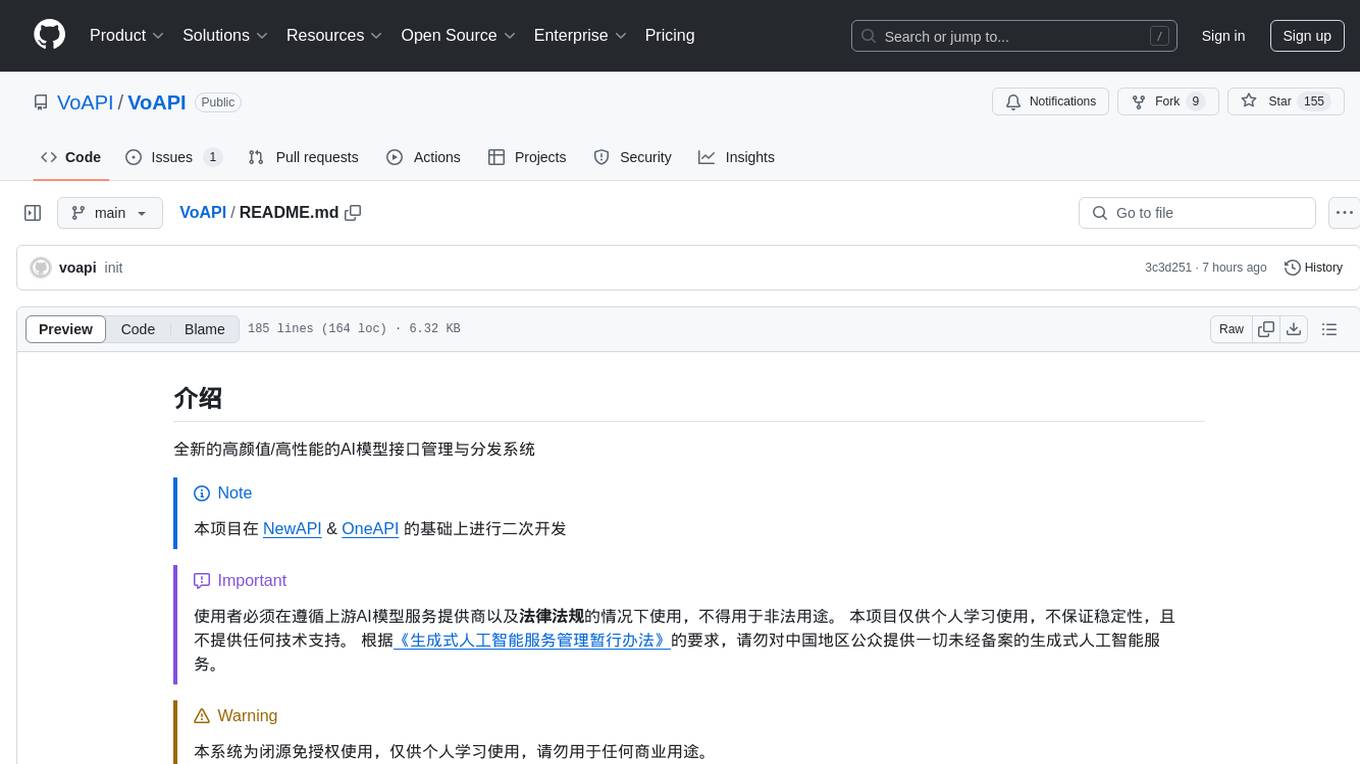
VoAPI
VoAPI is a new high-value/high-performance AI model interface management and distribution system. It is a closed-source tool for personal learning use only, not for commercial purposes. Users must comply with upstream AI model service providers and legal regulations. The system offers a visually appealing interface with features such as independent development documentation page support, service monitoring page configuration support, and third-party login support. Users can manage user registration time, optimize interface elements, and support features like online recharge, model pricing display, and sensitive word filtering. VoAPI also provides support for various AI models and platforms, with the ability to configure homepage templates, model information, and manufacturer information.








